
by admin
AI avatars have moved far beyond cartoon filters and novelty apps. In 2025, they’re redefining how we present ourselves online — from personalized content on social media to branded spokespeople in marketing videos. Whether you’re an individual creator or part of a business team, a high-quality AI-generated avatar can act as your always-ready digital twin.
An AI avatar generator uses artificial intelligence to create lifelike representations of people — animated, still, or even interactive — based on photos, prompts, or style presets. And the quality? Better than ever. Advances in AI and visual processing have made it easier to generate avatars that feel expressive, realistic, and customizable.
In this guide, we’ll help you find the best AI avatar generator for your needs — whether you’re looking for free tools, mobile apps, or advanced solutions that create avatars from scratch. Let’s dive into the tools shaping digital identity in 2025.
How We Chose These Generators

Selecting the best AI avatar generators is less about exceptionally high-quality graphics. From numerous dozen tools released annually, we focused on those aspects of highest value to users — whether you’re developing content to post to Instagram, making character assets to integrate into your game, or building a virtual representative of your business.
First and foremost, realism was at issue — just how realistic the avatars look and move. An advanced digital character needs to be immersive and never off-putting nor robotic. Other than that, diversity mattered. We wanted to have software where users can create avatars with different styles, body types, and moods.
Usability was paramount as well. Some websites don’t require any design experience at all, and others need you to have some level of technical know-how. We considered both options.
We balanced free versus paid features — not just what’s free, but whether or not paid tiers are worth it.
Finally, we looked at output quality. Does the generator produce still images, animated avatars, or video-ready content? Can the files be used across social media, YouTube, game engines, or enterprise platforms?
From creators to marketers to indie game devs — these tools have use far beyond novelty. So we picked solutions that truly deliver.
Top 7 AI Avatar Generators in 2025
Not all AI avatar tools are built the same. Some focus on hyper-realistic video avatars for business, others on stylized portraits for social media. Whether you want to make an AI avatar for your Twitch profile, marketing campaign, or personal brand, there’s a tool out there tailored to your needs.
We’ve tested and compared dozens of popular platforms and narrowed it down to seven that really stand out in 2025 — based on realism, features, ease of use, and the kind of content you can create. From polished video presenters to artsy cartoon styles, here’s our take on the best of the best.
Synthesia

If your goal is to create video avatars that actually talk — not just static profile pics — Synthesia is a strong contender. Originally built for corporate training and explainer videos, it’s now used by marketers, educators, and small business owners who want to replace on-camera filming with smart, polished AI presenters.
The process is simple: choose an avatar, type your script, and let the system turn it into a video with realistic lip-syncing. You can also clone your own voice and use your own avatar if you’re on a higher plan.
Strengths
- High-quality avatars with natural motion and expression
- Multilingual voice support
- Ideal for explainer videos, training content, and branded video messaging
Limitations
- Not great for casual users or creative expression — very business-focused
- Requires a paid plan for most features
- Limited customization of avatar appearance in lower tiers
Synthesia isn’t the best AI avatar app for selfies or fun — but it’s excellent if you need professional, video-ready avatars at scale. Think: onboarding videos, product walkthroughs, or educational content where you want a consistent, polished look.
MagicShot AI
MagicShot AI is built for people who want to create multiple versions of themselves — not just one perfect selfie. It’s especially popular with social media users, digital creators, and professionals looking to generate a wide range of stylized portraits for content and branding.
Upload a few photos, choose your styles, and the platform spits out dozens of unique AI-generated avatars: cartoon, cyberpunk, watercolor, anime, fashion editorial — you name it. It’s easy to use, and most results look polished enough to use as profile pictures, thumbnails, or promo visuals.
Strengths
- Huge variety of artistic styles
- Simple interface with no learning curve
- Great for creating eye-catching content fast
Limitations
- Mostly image-based — no video or animation support
- Not suited for professional business use (e.g., training videos)
- Best results require high-quality photo input
If you’re looking for the best AI avatar creator to experiment with different aesthetics or update your personal brand visuals, MagicShot AI is a fun, flexible option.
Fotor AI Avatar Generator

Fotor has been around as a photo editor for years, but its AI avatar generator has become a standout feature in 2025. It’s a great choice for anyone who wants quick, creative avatars without diving into complex tools or pricey subscriptions.
The Fotor AI Avatar Generator lets you generate dozens of avatars by uploading a few selfies — similar to Lensa or MagicShot — but with smoother output and better color harmony. It leans toward polished, semi-realistic styles with just enough flair to make your avatars pop on social media or websites.
Strengths
- Accessible to beginners
- Reliable output even with average-quality photos
- Includes editing tools to tweak results
Limitations
- Mostly focused on headshots
- Limited to static images
- Some features hidden behind a paywall
If you’re searching for the fotor AI avatar generator that balances speed, quality, and ease of use, this is an easy one to recommend — especially for influencers, coaches, and creators.
Picsart AI Avatar
If you’re already familiar with Picsart as a creative editing app, you’ll be glad to know its AI avatar generator online tool is just as intuitive. It’s geared toward casual creators, Gen Z users, and anyone who wants a personalized digital look for their socials without spending hours tweaking settings.
Upload a handful of selfies, and you’ll get back stylized avatar sets in various aesthetics — futuristic, dreamy, gritty, cartoonish. The avatars are clearly AI-generated, but that’s part of the appeal: they’re bold, vibrant, and perfect for platforms like TikTok, Instagram, or Discord.
Strengths
- Mobile-first, quick, and fun to use
- Great for personal branding and content creation
- Integrated with Picsart’s broader editing tools
Limitations
- Limited realism — not great for business use
- Subscription needed for full access
- May repeat certain looks if you don’t upload diverse photos
As an AI avatar generator online, Picsart hits the sweet spot for users who value speed, color, and content-ready visuals over ultra-precise realism.
Ready Player Me

Ready Player Me takes avatars into the world of 3D. If you’re building a virtual world, VR experience, or game — or just want a fully rigged 3D version of yourself — this is hands-down the best avatar generator in that space.
It’s especially popular among developers and game designers because of its wide compatibility with Unity, Unreal Engine, and WebXR. You start by uploading a selfie, and the platform creates a full-body avatar you can customize in style, outfit, and movement. It’s also used in virtual meetings, social VR platforms, and metaverse-style apps.
Strengths
- Generates ready-to-use 3D avatars
- Integrates well with development pipelines
- Ideal for gaming, VR, and interactive platforms
Limitations
- More technical than image-based avatar apps
- Requires understanding of game engines for full use
- Limited options if you’re looking for stylized 2D content
If you’re building for Web3, gaming, or immersive tech, this may be the best avatar generator for bringing your virtual self to life in real-time environments.
Reface App
Reface made a name for itself with real-time face-swapping and viral deepfake content, but its newer avatar tools have given it a fresh edge in 2025. If you’re after quick, animated, personality-filled avatars for memes, messages, or fun promos, this might be the best free AI avatar generator for you.
The app lets you create animated avatars that lip-sync, emote, and mimic expressions. It’s not meant for polished professional output — but that’s exactly why it works so well on platforms like TikTok, Snapchat, and Reels. It’s fast, weirdly accurate, and way more engaging than a still image.
Strengths
- Totally mobile, built for viral content
- Includes animated avatars and motion-based templates
- Many features are free or low-cost
Limitations
- Not business-oriented
- Output isn’t high-res enough for large-scale media use
- Data/privacy concerns with some users
If you’re focused on fun, humor, or storytelling, this is one of the best ways to experiment without spending a dime. For sheer personality, it’s a standout among the best free AI avatar generator options.
Lensa AI (by Prisma Labs)

Lensa exploded in popularity for its dreamy, highly stylized portraits — and its best AI avatar maker features in 2025 continue to deliver. It’s designed for people who want something more aesthetic than realistic: think painterly effects, fantasy themes, and Instagram-worthy images.
Upload 10–20 photos, choose a style pack, and get back dozens of variations. Some look cinematic, some lean into anime or fantasy, and others have that bold digital art vibe that works great for personal branding or content aesthetics.
Strengths
- High-quality, artistic results
- Super easy to use with a sleek mobile interface
- Beautiful filters and visual themes
Limitations
- No animation or video options
- Style packs can get expensive
- Output sometimes over-processes faces
As a best AI avatar maker, Lensa isn’t built for corporate needs — but it’s perfect if you want avatars that feel more like art than identity. Creators, freelancers, and influencers will find a lot to love here.
Custom-Built AI Avatar Generators: Scrile AI as Your Development Partner

Choosing the best AI avatar generator is great if you’re creating content for fun or personal branding. But what if your goal is bigger — launching your own product, offering avatar features in your app, or building something truly custom that no one else has? That’s where Scrile AI becomes more than just a name — it becomes your technical partner.
Scrile AI is not a tool, template, or marketplace. It’s a custom software development service that helps startups, businesses, and creators build their own AI avatar generator from scratch — fully tailored to their goals, user experience, and branding. You bring the idea. Scrile brings the engineering, AI models, and product infrastructure to make it real.
Their team can build advanced functionality, including:
- AI-powered face generation and photo-to-avatar transformation
- Model training for custom styles, voice, animation, and emotional expression
- Support for real-time video avatars, screen recording, and voiceovers
- Workflow integration with messaging, content publishing, and user accounts
- Custom dashboards for managing avatars, user data, and moderation
Most tools on the market force you into their limitations. With Scrile AI, you build your own product — not rent space in someone else’s. That means full ownership of your technology, your data, and your brand. No subscription traps. No API rate limits. No licensing headaches.
Want your avatars to look, sound, and move the way you envision? Want to sell avatar-based content directly to your users? Scrile builds that for you — tailored to your market and tech stack.
If you’re ready to move from user to creator, and from idea to product — get in touch with Scrile AI. Your custom avatar solution starts with one smart conversation.
Conclusion
AI avatar generators have come a long way — from novelty filters to powerful tools used across marketing, gaming, education, and content creation. The options available in 2025 are more diverse, realistic, and customizable than ever. Whether you’re looking to boost your personal brand, add some personality to your social presence, or automate your company’s video content, there’s a best AI avatar generator out there for you.
If your goals go beyond using what already exists — if you want to build your own solution, control the user experience, and scale on your terms — Scrile AI is the partner you need. Their team helps businesses and creators develop custom avatar software with full ownership and flexibility baked in from the start.
Ready to take that next step? Reach out to Scrile and turn your vision into a tailored AI avatar platform that stands out from the crowd.

by admin
Knowing how to make an AI chatbot in 2025 is less about coding and more about clarity — because AI bots aren’t just hype anymore. They’re running help desks, chatting up customers, selling subscriptions, and even simulating intimacy through NSFW chat experiences like Candy AI.
Whether you’re a solo founder building a niche app or a business owner automating support, chatbots have become essential tools. Some answer FAQs. Others act like personal assistants. A growing number? They’re designed for companionship, education, or paid fan interactions — and users expect them to sound human, remember things, and work across platforms.
You don’t need to be a developer to build one. But you do need to understand how they work, what options exist, and what makes a chatbot actually useful (and not just noisy). This guide breaks it all down — from quick-build tools to custom AI platforms with monetization built in.
Why Chatbots Still Work in 2025

If you’re wondering how to make an AI chatbot that people actually want to use, start with this: the market is thriving. According to Grand View Research In 2025, the global chatbot market is projected to exceed $27 billion, driven by demand across ecommerce, health, entertainment, and adult industries. Bots aren’t replacing humans — they’re augmenting them, doing the repetitive stuff faster and around the clock.
And they work. Studies show that AI-powered chat outperforms static FAQ pages and clunky help forms. Why scroll through a support database when you can just ask a bot?
Here’s where people are using them:
- Ecommerce brands use them as product recommenders and upsell engines.
- Mental health startups are building bots as virtual therapists or check-in partners.
- Hotels and clinics rely on chatbots for bookings and reminders.
- Fan sites and creators use chat to build loyalty through personalized interaction.
- And yes, NSFW AI bots — inspired by services like Candy AI — are becoming a mainstream monetization channel for adult content creators.
People are getting more comfortable chatting with bots, especially when the bot remembers things, responds with nuance, and sounds like an actual personality — not just a script.
If you’re considering creating an AI chatbot for your business or platform, the use cases are wider (and more profitable) than ever. It’s all about building something that feels human — without needing a human on the other end.
Pick Your Bot Type First
Before you even ask how to make an AI chatbot, you need to know what kind of chatbot you’re building — because not all bots are designed to do the same job.
Some bots are built to handle support tickets and help customers navigate FAQs. Others are made to capture leads, qualify prospects, or drive product sales. And increasingly, chatbots are being used for creative and highly personalized experiences — from writing assistants to NSFW AI bots and even fan roleplay companions.
Here are just a few types you might consider:
- Support bots for troubleshooting and onboarding
- Lead capture bots that gather emails and segment traffic
- Writing or knowledge bots to help brainstorm, draft, or summarize
- NSFW-style AI companions for entertainment or monetization
- Character bots or fiction-based personas for fandom interaction
- Booking bots for scheduling and reminders
Every chatbot solves a different problem. And if you’re creating an AI chatbot for a specific use case, getting clear on that problem first will shape every decision: the tone of voice, the backend logic, and the tools you’ll need.
No-Code and Low-Code Options

Not everyone building a chatbot in 2025 is a developer — and the rise of no-code and low-code tools proves that. Platforms like ChatBot.com, Tidio, and Landbot have made it possible for almost anyone to launch a functioning AI assistant in less than a day. These tools offer visual builders, simple logic flows, and pre-built conversation templates, so even someone without a tech background can piece together a working bot.
If you’re running a small business or need a basic virtual assistant, these platforms can do a lot. You might want a chatbot on your Shopify store to handle product questions, process simple returns, or guide customers to the right category. Or maybe you need something that helps book appointments, answers FAQs, or directs visitors to the right department. These tools are ideal for those kinds of jobs.
The biggest benefit of going the no-code route is speed. It’s fast to launch, affordable to test, and easy to manage without a dedicated dev team. You can tweak flows, add messages, and adjust triggers in a visual dashboard with little effort. But with that simplicity comes limitations. These tools aren’t built for deep customization. You can’t always control tone or personality, and memory is often limited to a single session — which can be a dealbreaker for more interactive or emotionally intelligent bots.
For many, though, that trade-off is fine. If your needs are straightforward and your brand doesn’t rely on advanced logic or tone-sensitive replies, these platforms offer a great entry point. Still, if you’re thinking long-term — or want your bot to actually sound human, remember context, or monetize — no-code tools might feel like a short-term fix.
Understanding how to create an AI chatbot is as much about knowing your options as it is about knowing your limits.
Building Your Own: Custom Chatbot Architecture
If you want total control over how your bot looks, talks, and behaves, then you’re probably thinking about going custom. Learning how to make an AI bot from scratch gives you flexibility that no template-based builder can match. This is where things get technical — but it’s also where they get powerful.
The Anatomy of a Custom AI Chatbot
A solid architecture starts with three essential components: the user interface (chat screen or voice interaction), the AI engine, and the logic layer that holds it all together. For the UI, you might use a web or mobile front-end designed in React, Vue, or Flutter. It’s the part the user sees and interacts with. Behind the scenes, the real work happens.
Most modern bots hook into powerful APIs like OpenAI (GPT-4), Claude, or Mistral for generating responses. These engines don’t “understand” in a human sense, but they’re excellent at language prediction, tone matching, and context generation — especially when guided by well-structured prompts.
That’s where prompt engineering comes in. A strong prompt is more than “talk like a pirate.” It’s a carefully crafted instruction set that sets tone, role, memory behavior, and guardrails. You can also integrate LangChain for building logic flows or multi-turn conversations, and tools like Pinecone or Weaviate to manage vector-based memory — so your bot can “remember” things users said days or weeks ago.
You’ll also need a backend — Firebase is a popular choice — to store user data, authentication, and interaction history. Combine this with analytics and optional payment integration, and you’ve got the bones of a real product.
Use cases are only growing. Some developers build bots that write poetry in the user’s tone. Others create Candy AI-style NSFW companions, trained on romantic or explicit fiction and designed for real-time, emotionally adaptive responses.
If you’re considering custom AI chatbot development, this is the route that lets you build exactly what you want. But it also means thinking like a product owner, not just a builder. That’s the trade — freedom for complexity.
What a Good AI Bot Needs in 2025
Building a chatbot is one thing. Building a good one — the kind users actually enjoy talking to — is something else entirely. Whether you’re creating an AI chatbot for a business, a creative project, or something more personal, the difference between “meh” and “wow” usually comes down to a few key features.
Memory is at the forefront. The very best 2025 bots don’t just react in the moment – they remember context. This may involve tracking a user’s name and tastes or reading a series of conversations over several months. Without memory, exchanges become shallow, mechanical, and unmemorable.
There’s also tone. Your bot may not have to feel, at least not in an emotional way, but it will need to respond in ways that will feel empathetic or energetic when required by circumstance. Insert some safety rails and moderation filters, particularly if your bot is dealing with sensitive subjects or NSFW material, and you’ve got something that will feel complete and credible.
Smart bots also connect to other tools. Want to process payments? Integrate with Stripe. Want to notify users or sync to groups? Plug into Telegram or Discord. APIs are your best friend here.
Privacy is another deal-breaker. If your chatbot handles personal or adult interactions, strong privacy controls and user filters are essential. Clear terms, encryption, and opt-in systems go a long way toward building user trust.
Finally, language flexibility is key. A growing number of bots are expected to handle multiple languages or offer seamless translation on the fly — especially when used in global communities.
These aren’t just features. They’re expectations. The bar is higher now, and the bots that stand out are the ones that feel less like widgets — and more like something real.
Scrile AI: Building Custom Chatbots that Work — and Sell

Once you’ve explored prebuilt tools and basic frameworks, one thing becomes clear: real success with chatbots doesn’t come from off-the-shelf options. If you want full creative control, long-term ownership, and real monetization potential, it’s time to think about how to make an ai chatbot with a custom approach.
That’s where Scrile AI stands out. It’s not a plug-and-play chatbot builder or a SaaS subscription with rigid limitations. Scrile AI is a custom development service — a technical team that helps founders, startups, and creators launch their own branded, scalable AI chatbot platforms from scratch.
The difference? You don’t just get a bot — you get an entire product.
Scrile AI specializes in custom chatbot solutions designed for business models where personalization and revenue matter. That includes NSFW platforms, fitness coaching, fan communities, subscription services, and interactive education tools. These aren’t bots bolted onto an existing website — they’re full ecosystems built around user interaction, automation, and monetization.
Some of the use cases Scrile AI delivers:
- Subscription-based customer service bots for SaaS platforms
- Adult AI chatbots like Candy AI — private, monetizable, with built-in pay-per-message models
- Fitness and wellness coaches using chat-based programs, journaling, or daily feedback
- Dating site bots that simulate human conversation with realistic pacing, tone, and memory
- Fan hubs and roleplay platforms where characters interact in real time
And it’s not just about chat. Scrile builds systems that include:
- Custom-designed UIs tailored to your brand
- Full payment integration: Stripe, crypto, PPV, or affiliate models
- Scalable backend infrastructure and long-term chat memory
- Admin dashboards with user analytics and content moderation
- NSFW-friendly setup with privacy layers and content filters
- Voice, avatar, or live cam modules (optional)
Why choose Scrile?
Because launching from scratch doesn’t mean reinventing the wheel — it means skipping generic and building what actually fits.
With Scrile, you get:
- Fast time to market with agile rollout plans
- No vendor lock-in — you own everything
- Customization at every level, from UX to AI personality
- Clear pathways to monetize without third-party rules
If you’re looking for custom chatbot solutions that actually serve your business, Scrile AI gives you the control, tools, and support to make it real — and profitable.
Conclusion
The chatbot space in 2025 is more powerful and more versatile than ever. Whether you’re building a friendly customer service assistant, a creative storytelling bot, or even a romantic AI companion inspired by platforms like Candy AI, the tech is there — and it’s surprisingly accessible.
You no longer need a massive dev team or a year-long roadmap to launch something functional. If you just want a simple bot that handles support or collects leads, no-code platforms can get you going fast. But if your goals include deeper personalization, real AI memory, monetization, or NSFW functionality, that’s where things shift. The question isn’t just how to make an AI chatbot, but how to make one that actually reflects your idea — your brand, your voice, your audience.
And that’s where custom development makes all the difference. You get total control, data ownership, and the freedom to build a product that grows with you — not within someone else’s limitations.
Scrile AI was built for that purpose. They’re not handing you a template. They’re helping you create something original, branded, and ready to launch — fast.
If you’re ready to stop renting chatbot tools and start owning your vision, talk to Scrile AI. They’ll help you build the chatbot you’ve been imagining — and make it something users will actually want to talk to.

by admin
The creative process isn’t disappearing — it’s just getting an upgrade. In 2025, writers aren’t fighting against AI; they’re collaborating with it. From novelists and screenwriters to indie creators and poets, more people are using intelligent tools to get unstuck, find their voice, or spin ideas into something usable.
What used to take hours — refining tone, rewriting awkward dialogue, brainstorming an opening line — now takes minutes. The best AI for creative writing doesn’t replace your voice. It supports it. It can suggest a line that sounds more like your character, help you experiment with mood, or reshape a meandering scene into something that actually flows.
Some apps are built for structured storytelling. Others shine when you need loose, wild ideation. And a few are surprisingly good at understanding nuance — emotional subtext, pacing, rhythm. The question isn’t “Should I use AI to write?” It’s “Which tool is worth it?”
This article breaks down the top creative writing AI apps in 2025 — who they’re for, what they’re good at, and where they might fall short. And if you’re a founder, ghostwriter, or fiction entrepreneur looking to build something custom? We’ll also show how Scrile AI can help you create your own writing assistant from scratch — trained on your tone, built for your audience, and ready to scale.
What Makes an AI Tool Creative?

Not all writing AIs are built the same. Some are glorified autocomplete engines — great for product descriptions or blog intros, but hopeless when it comes to writing a scene that actually feels like something. Creative writing is a different animal entirely. It’s about style, rhythm, character, emotional flow — not just spitting out grammatically correct sentences.
The best AI for creative writing in 2025 doesn’t just write quickly. It writes with voice. That means adjusting tone, mimicking a character’s perspective, or reworking a paragraph so it feels right, even if it breaks the rules of formal grammar.
Modern tools like Claude have gotten significantly better at this. Thanks to bigger context windows (they can now “remember” more of what you’ve written), they can track plot arcs, personalities, and pacing. Some even let you lock in a character’s tone so it stays consistent across a whole conversation or story.
There’s also training. Tools like Sudowrite are fine-tuned on fiction. That means they know how to finish a short story, or rewrite a flat sentence into something with texture. For example, say you’ve written a line of dialogue that sounds like it came from a tax attorney. You can ask the AI to rewrite it so it sounds like a stoned bartender in a beach town — and it’ll probably nail it.
These aren’t generic chatbots anymore. They’re semi-coherent, style-aware co-writers. Some can shift tone between paragraphs. Others specialize in world-building or emotional dialogue. And the best ones give you just enough structure to avoid chaos — while still leaving room for the weird, human part of storytelling to shine.
That’s what makes them creative. Not perfection. Possibility.
The 8 Best AI Writing Apps for Creativity in 2025
There’s no shortage of AI tools out there — but when it comes to actual creativity, only a few are worth your time. Below, we’ve rounded up eight of the best AI for creative writing apps in 2025. Each one brings something different to the table, whether you’re drafting fiction, brainstorming ideas, or rewriting a scene that just isn’t landing.
Sudowrite – The Fiction Writer’s Secret Weapon

Who it’s for: Novelists, short story writers, fanfiction authors, or anyone writing narrative fiction
Sudowrite was built from the ground up for fiction writers. Unlike more generalized tools, it doesn’t just spit out ad copy or SEO blurbs — it actually knows how to build scenes, mimic character voices, and help you write prose that doesn’t sound robotic.
Its standout feature is “Story Engine,” a tool that lets you build characters, plan arcs, and write chapters while the AI keeps track of everything. You can feed it a paragraph and ask for sensory details, alternative dialogue, or even emotional tweaks. Stuck on a scene? It’ll help finish it in your tone. Want to rewrite a flat sentence? It’ll offer five options — including one that’s “more poetic” and one that’s “weirder.”
It also remembers long chunks of story, thanks to its larger context window. That means your character doesn’t suddenly change tone halfway through a scene.
Strengths:
– Designed specifically for fiction
– Flexible tone rewriting
– Excellent “Show, don’t tell” assistant
– Unique brainstorming tools like “wormhole” and “twist”
Flaws:
– Slight learning curve if you’re new to AI writing
– Sometimes outputs cliché or overly safe phrasing
Why it stands out:
Sudowrite feels like it was built by fiction writers for fiction writers. It doesn’t try to take over your story — it gives you better options when you’re stuck and lets you stay in control of your voice.
Jasper AI – Blending Creativity with Content Strategy
Who it’s for: Writers who juggle creative content and business writing, or need flexible tone-shifting
Jasper AI has long been a go-to for marketers and content teams, but it’s also surprisingly useful for creatives — especially those working across genres or formats. Its tone control tools are solid, and its built-in templates offer everything from story hooks to social-friendly blurbs.
It shines in hybrid creative workflows. If you’re writing a novel and need to build a back-cover description, Jasper can help. Need a scene rephrased in a sarcastic or romantic tone? Jasper handles that too. And if you’re writing for clients — say, ghostwriting steamy fiction while also managing their email list — this tool adapts fast.
The interface is clean and quick to navigate. Plus, Jasper’s “brand voice” settings let you train it on your style, which makes it much more useful for serialized or long-form writing.
Strengths:
– Tone flexibility across formats
– Solid at story starters and hooks
– Brand voice customization works well
Flaws:
– Not fiction-specific; less helpful for scene continuation
– Gets stiff or formal if you don’t guide it well
Why it stands out:
Jasper hits a rare middle ground: creative, but grounded. It’s one of the best AI for creative writing if your work blends storytelling, marketing, and the occasional splash of poetry.
Claude – Emotionally Fluent and Surprisingly Human
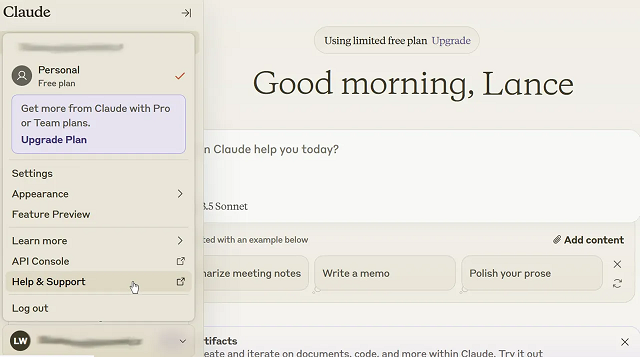
Who it’s for: Writers who care about nuance, emotional tone, and narrative flow
Anthropic’s Claude has emerged as a favorite among writers who need more than just competent text — they want their AI to actually “get” human emotion. And Claude does. Compared to more assertive, high-energy tools, Claude’s responses feel calm, deliberate, and often startlingly insightful.
This makes it especially good for creative writing. Claude is strong at continuing a narrative in the same voice, rewriting paragraphs with a softer or more dramatic tone, and understanding subtext in dialogue. It’s ideal for writers crafting sensitive character moments, emotionally complex scenes, or internal monologues.
Claude 3’s longer context window also helps — it can “remember” much more of your work as you write, allowing it to stay consistent over several pages. You can feed it an entire chapter and ask for notes, edits, or alternate takes on key scenes.
Strengths:
– Natural, emotionally intelligent language
– Excellent for tone matching and dialogue
– Long-form consistency
Flaws:
– Doesn’t come with a built-in UI — best used through third-party tools or dev setups
– Occasionally too passive or cautious in suggestions
Why it stands out:
Claude is less flashy than other tools, but it’s one of the best AI for creative writing if your work leans on subtlety, sensitivity, and strong voice control. It feels more like a writing partner than a machine.
Copy.ai – Fast, Flexible, and Idea-Driven
Who it’s for: Creators juggling copy and creativity — social writers, short story dabblers, content marketers with a narrative streak
Copy.ai is known for fast content generation, but that doesn’t mean it can’t be creative. If you’re looking for a tool that can help spark story ideas, reframe a scene in a punchier way, or turn a vague prompt into something usable, this one’s surprisingly versatile.
Its real strength lies in short-form ideation. Writers use Copy.ai to brainstorm story titles, pitch concepts, rewrite blurbs, or turn journal entries into structured scenes. While it isn’t purpose-built for fiction, it works well as a drafting assistant — especially in early-stage idea development or voice experimentation.
The interface is clean and fast, and it lets you shift tone easily. You can also train it slightly by feeding previous writing samples or using its prompt enhancer feature.
Strengths:
– Great for brainstorming and quick rewrites
– Easy to use for multi-format writing
– Good tone-shifting tools
Flaws:
– Not ideal for long-form or full-scene continuity
– Lacks the depth fiction writers may want for arcs or dialogue
Why it stands out:
Copy.ai is one of the best AI for creative writing if you’re early in your process or looking to keep your writing fresh. It won’t finish your novel — but it might help you finally start it.
Notion AI – From Notes to Drafts in One Click
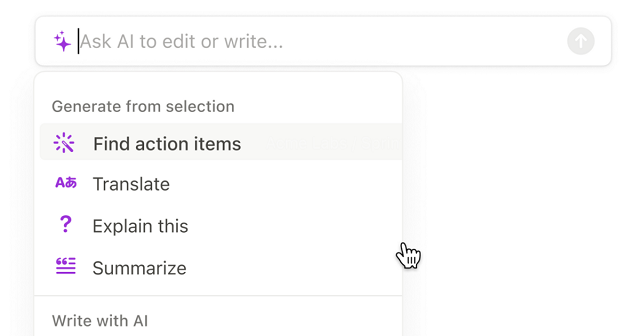
Who it’s for: Creative thinkers who work in outlines, notes, or scattered ideas
Notion AI isn’t a traditional writing app — and that’s what makes it useful. Built into the broader Notion workspace, it’s perfect for writers who brainstorm in chunks: notes, bullet points, scene fragments, character boards. It helps bridge the gap between scattered ideas and something resembling a real draft.
You can highlight a messy block of text and ask Notion AI to rework it into paragraphs. Or give it a prompt like “turn this list into a poetic description” — and it often surprises you. It’s especially useful for those who plot stories in Notion already, or use it as a second brain for creative projects.
That said, Notion AI is still limited. It’s not optimized for story arcs or tone consistency across scenes. But for what it does — fast, flexible synthesis of messy notes — it’s genuinely helpful.
Strengths:
– Perfect for idea-to-draft conversion
– Feels natural for Notion users already organizing their writing
– Handles tone changes well within a short form
Flaws:
– Not built for deep narrative or long-form fiction
– Limited memory and continuity between prompts
Why it stands out:
If your creative process lives inside Notion, this is a no-brainer. Notion AI is one of the best AI for creative writing if you’re constantly jumping between outlines, dialogue sketches, and half-formed ideas.
Rytr – Budget-Friendly and Surprisingly Capable
Who it’s for: Writers on a tight budget who still want creative support
Rytr doesn’t make headlines, but it punches above its weight for the price. For under $10/month, you get a clean interface, tone customization, and a solid variety of use cases — including storytelling, poetry, and creative descriptions.
It’s especially good for early drafts. You give it a short prompt or a few bullet points, and Rytr spins it into something usable. It won’t nail complex arcs or subtle character beats, but it’s great at rewording, summarizing, or throwing out ideas when you’re blocked.
The tone controls are easy to use — and surprisingly specific. You can request “humorous,” “convincing,” or “narrative” tones and watch your writing shift accordingly. It’s ideal for short stories, content blurbs, or even RPG world-building prompts.
Strengths:
– Very affordable
– Great for short creative tasks
– Clean and simple interface
Flaws:
– Struggles with long-form or layered scenes
– Occasionally generic without strong prompts
Why it stands out:
Rytr is one of the best AI for creative writing if you’re on a budget and want help generating or reshaping content. It’s not fancy — but it gets the job done better than you’d expect.
Writesonic (Chatsonic) – Experimental and Versatile

Who it’s for: Writers who like to test tone, remix style, or push genre boundaries
Writesonic’s Chatsonic feature is one of the more flexible AI tools out there. It’s a conversational interface like ChatGPT, but with real-time web access (optional), built-in personas, and plenty of voice-shifting options. If you’re the kind of writer who likes to say “give me a weird version of this paragraph” or “rewrite this as if it’s narrated by a washed-up detective,” Chatsonic will actually try.
It supports long-form writing reasonably well — not at the level of Sudowrite or Claude, but better than most generic bots. And it’s fun to experiment with. Whether you’re drafting strange genre crossovers, writing fiction for newsletters, or testing tone for character dialogue, it gives you options that feel fresh.
Its free tier is limited, and the interface can be busy. But if you’re a flexible, idea-driven writer who thrives on prompts, this tool can unlock unexpected directions.
Strengths:
– Highly experimental
– Great at voice play and tone shifts
– Option for web-connected generation
Flaws:
– UX can be overwhelming
– Requires strong prompting for best results
Why it stands out:
Chatsonic is one of the best AI for creative writing if you want to push boundaries or just see what happens when you let the AI get weird. It’s not polished — but that’s kind of the point.
Lex.page – Minimalist Writing, Maximum Focus
Who it’s for: Writers who hate clutter and just want to write
Lex isn’t trying to be everything. It’s a distraction-free writing space with built-in AI features that actually feel helpful. The interface is bare bones — like Google Docs stripped down to its essentials — and that’s exactly what makes it work for creatives.
The AI works in-context. You can ask it to finish your sentence, generate alternative phrasings, or even pitch better transitions. It’s not trying to manage your story arc or world-building. It’s just there to help you move forward when you stall.
Lex shines in the early and mid stages of writing — when you’re putting down messy ideas and want help sharpening them up. It’s not for outlining or planning. It’s for writing.
Strengths:
– Minimal UI, fast workflow
– Great for polishing drafts without overcomplicating them
– In-line suggestions feel natural
Flaws:
– Lacks structure or creative templates
– Not suitable for complex fiction building
Why it stands out:
Lex is one of the best AI for creative writing if you just want a clean, focused place to write — with a little AI support when you need it, and silence when you don’t.
Why Some Writers Still Build Their Own Tools

Even with all the polished AI tools on the market, not every writer finds what they need out of the box. That’s especially true for creators working in niche genres, serialized fiction, interactive storytelling, or erotica — where tone, format, and audience expectations often push the limits of what standard AI writing tools are built for.
Sometimes it’s less about what a tool can do, and more about what it doesn’t let you control. Want your AI to write in your exact tone? That’s tough without training a model on your own writing. Want a chatbot that responds like your character would? Good luck customizing that deeply with most commercial tools. What if you need a place to host fan-written stories behind a paywall, or build an AI editor that gives scene-level feedback based on your specific narrative style?
That’s where custom AI comes in — and more writers are realizing they don’t have to wait for someone else to build it.
Indie creators, ghostwriters, digital publishers, and even roleplay game writers are quietly hiring developers to build tools that match their vision. Some want an AI writing assistant trained on their past work. Others want full platforms — complete with subscription monetization, user-generated content tools, or AI character bots. Some even want “closed-loop” systems: tools that write, edit, publish, and track engagement, all under one roof.
It’s not about ditching the creative process. It’s about designing tools that fit into your workflow, your market, and your voice — instead of forcing yourself to adapt to a tool made for someone else’s goals.
And if you’re serious about that route, building from scratch isn’t as wild (or expensive) as it used to be. That’s where Scrile AI comes in. Let’s talk about that.
Build a Custom Creative Writing AI App with Scrile AI
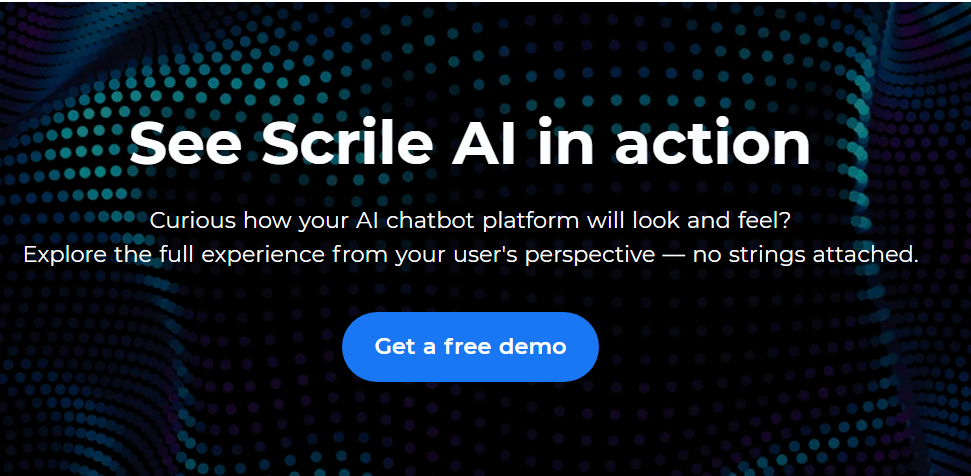
Most off-the-shelf writing tools are designed to be one-size-fits-all. That’s great for convenience — until you realize that convenience comes at the cost of flexibility, control, and long-term growth. If you’re serious about building a creative writing product that does more than generate text, you need something that’s yours from the ground up.
That’s where Scrile AI comes in. It’s not a plug-and-play app. It’s a full-scale custom development partner for founders, publishers, and creators who want to launch unique AI-powered platforms tailored to their voice, workflow, and audience.
Let’s say you’re a fiction writer with a massive back catalog and want to turn your style into an AI co-writer. Or you’re a digital publisher looking to build a platform for serialized fiction, complete with reader interaction, content controls, and pay-per-story monetization. Scrile can build that — and much more.
Here’s what Scrile AI can help you create:
- AI writing assistants with memory, tone control, and plot-awareness
- Character development tools trained on your world and lore
- Interactive storytelling apps with reader input or chatbot-style narration
- Monetized platforms for creators, featuring subscriptions, tips, or affiliate links
- NSFW-friendly tools for erotica writers, adult publishers, or fantasy roleplay
- Teacher or tutor tools for creative writing courses with AI feedback built in
Unlike generic SaaS tools, Scrile’s solutions are:
- Fully branded — your name, your domain, your UI
- Data-private — you control the training data and who sees it
- Legally yours — no terms of service conflicts when it comes to AI-generated content
- Flexible for growth — built to scale, integrate, and monetize however you want
Whether you’re a solo author building a writing assistant, or a startup launching the next Wattpad-style platform, Scrile AI brings the backend muscle and frontend polish to help you launch fast — and scale with confidence.
And yes, that includes romance, smut, fanfiction, or whatever other genre mainstream tools tend to shy away from.
If you’ve ever thought, “I wish there was a tool that did this,” Scrile can help you build it.
Conclusion
Creative writing isn’t going anywhere — it’s just evolving alongside the tools we use. The rise of AI hasn’t made writers obsolete. If anything, it’s given them new ways to work, experiment, and push past creative blocks. Whether you’re crafting novels, building fanfiction communities, or scripting interactive stories, the right AI can enhance your process without taking it over.
Tools like Claude, Jasper, and Sudowrite are already helping thousands of writers draft faster and rewrite smarter. But if you’re dreaming bigger — building your own platform, shaping AI in your voice, or monetizing a writing app that doesn’t exist yet — it might be time to go custom.
That’s where Scrile AI comes in. It’s not just another writing tool. It’s your development team for building something original. Explore what Scrile AI can help you create — and turn your creative vision into a working, scalable product.

by admin
There’s a limit to how many tabs we can juggle, how many tasks we can track in our heads, and how many calendar invites we can answer before something drops. Between back-to-back meetings, inbox chaos, and constant notifications, many people — from solo entrepreneurs to mid-sized teams — are burning time just trying to stay organized. It’s no surprise that interest in the AI personal assistant app category has exploded. These aren’t just smart to-do lists anymore. The best tools in 2025 actually think ahead — auto-scheduling your day, handling email threads, flagging potential conflicts, and learning from your habits over time.
While the tech itself is impressive, what makes these assistants so compelling is how specific they’ve become. There are AI tools built just for freelancers managing client work, apps designed for overwhelmed team leads, and others crafted for creators who want to streamline production without losing their voice.
And with large language models becoming more accessible, these assistants are no longer locked behind enterprise software. Anyone with a browser and a need for structure can try one — or build one.
In this article, we’ll walk through five of the most effective AI personal assistants available in 2025. We’ll cover what they do best, how they handle real-world tasks, and how you can use them to free up your time and focus on the work that actually matters.
Why AI Personal Assistants Are Evolving So Fast
Five years ago, most digital assistants were glorified reminder apps — they could ping you at 9 AM, maybe reschedule a meeting, and that was about it. Fast forward to 2025, and we’re looking at a completely different category of tools. Today’s AI personal assistants aren’t just reactive. They’re proactive, adaptive, and increasingly personalized.
This leap comes from a few major shifts in the tech behind the scenes. First, the rise of powerful large language models like GPT-4, Claude, and others has allowed assistants to hold natural conversations, understand nuance, and summarize complex threads of information. The best ones don’t just listen — they learn. They start to understand your priorities, your work rhythms, and even how you write.
Second, modern AI task assistant systems are built on smarter automation stacks. They connect with your calendar, Slack, project tools, email, and files — and then take action based on real-time data. It’s not just about scheduling anymore. It’s about doing things for you.
And finally, privacy and personalization have improved. The most advanced AI personal assistant app can now run in secure environments, giving users more control over what’s stored, shared, or deleted.
If you’re wondering how to use AI as a personal assistant, the answer is increasingly: however you want. The tools are catching up to your needs — and in many cases, anticipating them.
5 Best AI Personal Assistant Apps in 2025
There’s no shortage of tools claiming to make your life easier, but not all of them actually do anything for you. The apps below aren’t just organized interfaces — they function like real assistants. They schedule your meetings, sort your day, and anticipate your next move. Whether you’re running a solo business or managing a remote team, these five picks represent the strongest options on the market right now.
Motion — Real-Time Planning That Adjusts Around You
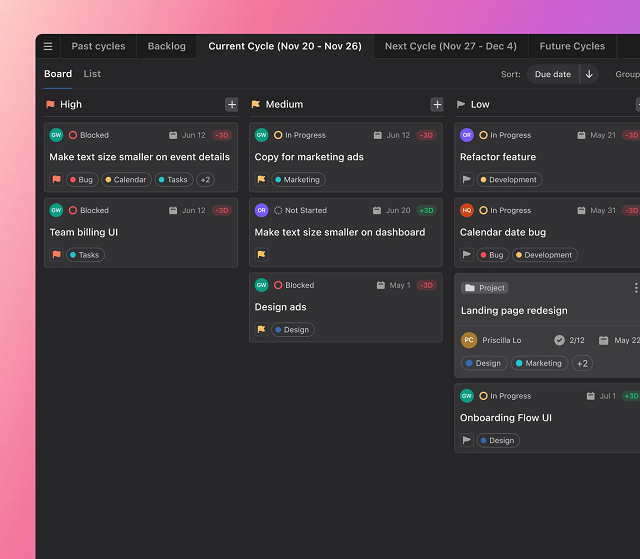
If your calendar is a mess, your tasks are scattered across apps, and you’re constantly re-planning your day, Motion steps in like a calm, invisible assistant. This tool blends calendar management, task planning, and prioritization — then uses AI to automate the rest.
What sets Motion apart is that it doesn’t just remind you what to do. It actively reschedules tasks based on shifting deadlines, meeting changes, and how long you actually need to finish something.
Key features include:
- AI-powered daily auto-scheduling
- Integration with Google and Outlook calendars
- Real-time updates when meetings shift or cancel
- Prioritization based on deadlines and task weight
- Smart focus time blocks for deep work
It’s built for people who need to defend their schedule without constantly managing it — remote workers, team leads, or solo professionals with unpredictable days.
Instead of building a routine around a tool, Motion builds your routine around you. It keeps things moving without the mental load.
For anyone looking to gain back hours without hiring a human assistant, Motion is easily one of the best AI personal assistant app options available in 2025.
Clara — Email Scheduling Without the Awkward Ping-Pong
Clara is an AI personal assistant app built for one thing: handling meeting coordination over email, so you never have to go back and forth again. But what sets it apart is its human touch. Instead of sending generic booking links, Clara actually reads the conversation, interprets tone, and replies like a real assistant.
It integrates directly with your calendar and jumps in when you CC it on an email. From there, it handles the rest — confirming time zones, checking availability, following up, and even rescheduling if needed. The emails are clean, professional, and surprisingly human.
Key features include:
- Email-based meeting scheduling with natural language
- Full calendar integration with Google and Outlook
- Support for multi-participant and recurring meetings
- Customizable tone and communication style
- Hands-free rescheduling and reminders
Clara is ideal for executives, client-facing professionals, or anyone who wants to skip the hassle of manual coordination — without sacrificing personal touch.
It may not be the flashiest tool, but as far as personal assistant software goes, it’s one of the smoothest experiences on the market in 2025.
Reclaim.ai — Protect Your Focus Without Losing Flexibility
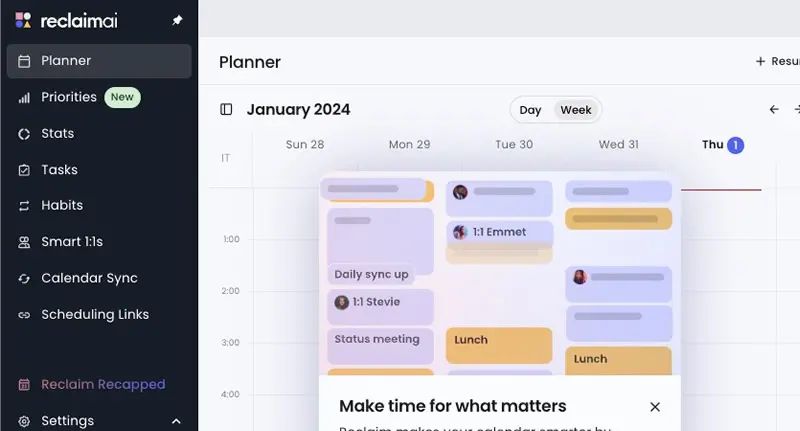
If you constantly feel like your calendar is working against you, Reclaim.ai might be the smartest fix. This tool acts like an invisible layer over your schedule — automatically blocking time for deep work, habits, and recurring tasks, while still adjusting when meetings come up. It’s designed for people who want more control over their day without micro-managing every hour.
The real value of Reclaim lies in how well it protects your priorities. You set goals for how often you want to work out, catch up on email, or prep for meetings — and Reclaim makes it happen by finding space for it in your calendar. When new meetings appear, it shifts things intelligently so you don’t lose momentum.
Key features include:
- AI time blocking for habits, tasks, and routines
- Automatic calendar syncing across platforms
- Real-time adjustments based on new events or conflicts
- Priority settings that align with personal and team goals
- Shared calendar visibility for teams
Reclaim.ai is one of the best AI assistants for work because it doesn’t just help you get things done — it helps you make space for what matters most. Especially valuable for remote workers, creatives, or anyone balancing project work and meetings.
Trevor AI — Calendar Meets To-Do List With Zero Clutter
Trevor is a hidden gem that marries a robust to-do list to scheduling in real-time, and it’s an excellent choice for someone who wants complete control of their day — but no unnecessary burden. Where more weighty productivity systems are heavy, Trevor is light and simple: it puts your items directly onto your calendar and uses artificial intelligence to inform you of when you should be doing what.
Where it shines is simplicity. You create your task list, choose some of the options, and Trevor provides you time blocks that actually work. No distractions, no unnecessary menus. It’s the kind of assistant that helps you create habits rather than reacting to chaos.
Key features include:
- Task-to-calendar syncing with drag-and-drop ease
- AI suggestions based on priority and availability
- Simple interface designed for solo users
- Integrates with Google Calendar
- Real-time time-blocking that updates as you go
Trevor AI is perfect for freelancers, consultants, and solo creators who want to manage time better without overloading on features. It’s clean, fast, and surprisingly good at keeping you on track.
Among the more focused tools on the names of AI assistants lists in 2025, Trevor earns its place for doing exactly what it promises — and doing it well.
Taskade AI — A Creative Workspace Powered by Collaboration

Taskade stands out in the manner in which it achieves the balance of productivity and creativity. It is not a helper that lets you do, but lets you think, co-create, and collaborate in projects in real-time. Designed specifically for remote teams, virtual creatives, and solo operators who don many hats, Taskade uses AI to automatically outline, structure ideas, and task manage in a single versatile workspace.
Unlike traditional assistants that focus only on scheduling or email, Taskade leans into structure and brainstorming. Whether you’re writing a content plan, mapping out a product launch, or just managing your weekly goals, it gives you smart suggestions and automates your repetitive workflows.
Key features include:
- AI-generated task lists, outlines, and mind maps
- Collaborative editing across devices
- Templates for marketing, content, and planning
- Natural language commands for creating or reformatting tasks
- Real-time sync with team members
If you want an assistant that feels more like a creative partner than a scheduler, Taskade AI delivers. It’s versatile, visual, and surprisingly intuitive.
As more tools flood the list of AI assistants in 2025, Taskade keeps its edge by balancing functionality with a playful, flexible interface — and that’s what makes it stick.
Scrile AI: Building a Custom AI Assistant for Your Business

Even the smartest tools on the market come with limits. Off-the-shelf solutions often force you to adapt your workflow to their features — not the other way around. You’re stuck with pre-set templates, limited branding options, and feature caps that eventually slow you down. If you’ve ever tried scaling a service around an app you don’t control, you know how frustrating that can be.
Scrile AI offers an alternative: a way to build your own AI assistant from the ground up. Not another tool — a fully customized platform tailored to your business, your users, and your growth strategy. Whether you need a productivity-focused AI, a chatbot with personality, or something completely unique, Scrile AI gives you full control over how it works and how it looks.
What Scrile AI can deliver:
- Custom-branded UI/UX to match your voice and audience
- Safe-for-work or NSFW conversational logic
- Built-in monetization: subscriptions, tipping, PPV
- Admin dashboard with analytics, CRM, and user controls
Use cases include:
- Adult creators launching AI companions (Candy AI-style)
- Influencers building interactive AI personas
- Businesses needing scheduling, customer support, or sales automation agents
The result isn’t just an app — it’s a business. One that doesn’t rely on third-party rules, algorithms, or app store restrictions. If you’re serious about building the best personal AI assistant for your brand or audience, Scrile AI helps you own every part of it — from backend logic to user experience.
Conclusion
AI personal assistants in 2025 aren’t just helpful — they’re becoming essential. Whether you’re managing a packed schedule, coordinating a remote team, or building your own AI product, the right tool can save hours and reduce stress. Off-the-shelf apps are a great starting point, but if you need full control, customization, and revenue potential, building your own assistant makes more sense.
Curious what that could look like? Get in touch with the Scrile AI team to explore how you can launch your own custom AI personal assistant app — exactly how you want it.

by admin
Live streaming isn’t limited to one industry or audience anymore. It’s used by everyone — from teachers running virtual classrooms, influencers hosting fan events, and content creators launching pay-per-minute shows, to large-scale streaming services and global tech companies powering massive live broadcasts. The demand for real-time connection is universal, and behind many of these experiences, one protocol quietly continues to do the work: RTMP.
So, what is RTMP protocol, and why is it still trusted in 2025?
Despite its age, RTMP remains a go-to method for getting video from source to server — fast, stable, and widely supported. In this guide, we’ll unpack how it works, where it fits in today’s tech landscape, and how you can use it to build your own streaming platform — whether you’re launching a niche startup or architecting a large-scale service.
RTMP Demystified: What It Does and How It Works
RTMP stands for Real-Time Messaging Protocol, and while it’s an oldie, it remains one of the most reliable building blocks in live video workflows. Macromedia developed RTMP in the early 2000s to stream audio, video, and data over the internet, and Adobe later adopted it. The protocol primarily served Flash-based playback. While Flash itself is no more, the protocol it used isn’t.
What keeps RTMP relevant in 2025 isn’t nostalgia. It’s usefulness. RTMP creates a long-duration TCP connection between the source (usually a live encoder) and the server. That is, rather than pushing bits of data, as more modern HTTP-based protocols do, RTMP has a steady, low-latency stream of information. It’s a continuous feed that works particularly well when timing matters — like live events, real-time interaction, or performance-based content.
RTMP’s Role in the Contribution Workflow
Most of the time, platforms used RTMP at the contribution stage to transfer content from the broadcaster to an RTMP streaming server.From there, other technologies (like HLS or WebRTC) typically take over to deliver the content to end viewers. RTMP still dominates this ingest phase because it’s fast, reliable, and widely supported across encoders like OBS, vMix, Wirecast, and even hardware streaming tools.
Here’s how a simple RTMP stream setup looks:
- A live camera feed is captured through an encoder
- The encoder pushes that stream using RTMP to a streaming server
- The server then handles playback distribution using HLS, WebRTC, or both
Another reason RTMP persists is how well it performs under poor network conditions. It’s not the most modern option, but it’s incredibly stable and easy to deploy — two traits that matter a lot when you’re dealing with unpredictable connections or limited budgets.
Of course, not everything about the original protocol fits today’s standards. That’s where RTMPS comes in. If you’re wondering what is RTMPS, it’s simply RTMP secured through SSL/TLS encryption. The encrypted variant is especially useful for platforms handling sensitive data, adult content, or private pay-per-view events. It ensures your stream can’t be easily intercepted or hijacked mid-transmission.
Maybe it’s no longer the technology powering your playback, but it’s still the protocol quietly handling the heavy lifting when your content first leaves the source — and for many streamers, that’s the most critical moment.
RTMP in 2025: Still Relevant or Outdated?

Developers designed RTMP long before smartphones and 5G entered the picture, but it’s still widely used. While it might seem outdated compared to newer streaming protocols, the RTMP protocol continues to play a vital role in modern live video workflows. It remains especially popular for getting a live video feed from the source — your encoder — to the server before it’s sent to the audience.
One reason it’s still around is that it just works. RTMP has stood the test of time because it’s:
- Easy to implement and well-documented
- Low-latency, with faster delivery than chunk-based protocols
- Supported by nearly every software and hardware encoder on the market
These strengths make RTMP the go-to solution for the “contribution” part of streaming — that is, the link between your broadcasting software and the server. From there, many setups now use a second protocol like HLS or WebRTC to handle playback, especially for mobile and browser-based viewers. This hybrid setup — RTMP in, modern protocol out — has become standard practice.
In 2025, streamers and developers still choose RTMP because it’s stable, flexible, and proven. It’s widely used in live cam platforms, coaching businesses, private membership-based streaming services, and even large-scale commercial platforms that want fast deployment and full control.
At the same time, infrastructure around RTMP is still evolving. Services like RTMP.pro now offer cloud-based RTMP ingestion, making it easier to build a modern workflow without sacrificing speed or reliability.
RTMP might not be the headline tech anymore, but it hasn’t gone away. For many use cases, it’s still the simplest and most dependable way to deliver real-time video from source to server — and that’s exactly what most streaming businesses need.
RTMP VS Other Protocols: Picking the Right Tool

When it comes to live streaming protocols, there’s no one-size-fits-all solution. Each has strengths and trade-offs, and choosing the right one depends on how you’re using it — whether you’re delivering to a global audience, operating a pay-per-minute cam site, or building a high-interaction virtual event platform.
Let’s break down how the RTMP protocol compares to three other common options: HLS, RTSP, and WebRTC.
RTMP VS HLS
This is one of the most common comparisons, especially for developers working on full-scale streaming platforms. The key difference? Many streaming workflows rely on RTMP for contribution, while HLS handles playback
RTMP sends video from the encoder to the media server. It keeps a persistent connection, which means low latency — often under 5 seconds, and in ideal setups, even lower. It is therefore an excellent choice for anything that involves real-time interaction, like live auctions, adult content streaming, or live chat-supported coach sites.
However, Apple developed HLS (HTTP Live Streaming) specifically to support scalable video delivery. It breaks up video into tiny pieces and sends them as HTTP, allowing for easy caching, worldwide distribution, and playing on nearly any device or browser. But it costs more in terms of latency: delays of 15–30 seconds are typical.
So comparing RTMP vs HLS, the rule is simple: utilize RTMP to feed content into the system in a hurry; utilize HLS to publish it in scale. Both are utilized by a lot of current streaming setups, which blend RTMP ingest with HLS delivery to strike a balance between real-time creation and level delivery.
RTMP VS RTSP
Another common comparison is RTMP vs RTSP. While they might sound similar, they’re built for very different things.
RTSP (Real Time Streaming Protocol) is often used in closed environments, like security camera systems, IP surveillance setups, or internal network video feeds. It supports real-time control — play, pause, record — which makes it great for video-on-demand or camera monitoring systems.
RTMP, in contrast, is more focused on delivering live video for web applications. It works better in browsers, integrates more easily with common encoders and CDNs, and is widely supported by public-facing streaming services. It’s also better suited to interactive live content, like virtual performances or monetized live chats.
So if you’re building a consumer-facing streaming site, RTMP protocol is generally the better choice. RTSP is fine for internal systems, but it’s rarely used in public streaming environments without complex configuration and support layers.
RTMP VS WebRTC.
WebRTC is the newest of the major streaming protocols and was designed for true real-time communication. It’s peer-to-peer, supports two-way audio and video, and delivers sub-second latency. On paper, it sounds like the perfect solution for any kind of live interaction.
But it comes with its own set of challenges. WebRTC is far more complex to implement and harder to scale without dedicated media servers. It also requires more resources from both the server and the viewer’s device. This makes it ideal for video conferencing or one-on-one chat, but not always the best choice for large public broadcasts.
RTMP, on the other hand, is easy to configure, works well with existing encoders, and can be scaled up using traditional media server setups. That’s why many developers don’t pick one — they combine both. RTMP handles content ingestion, and WebRTC delivers the final stream to users where latency needs to be as close to real-time as possible.
So RTMP is stable and easy to use. WebRTC is faster, but harder to manage. Use them together when your platform needs both simplicity and speed.
Who’s Still Using RTMP?

Despite being more than two decades old, the RTMP protocol continues to be part of the modern streaming stack — especially when it comes to contribution workflows. While newer protocols like HLS and WebRTC have taken over playback, RTMP still plays a critical role in getting content from creators to servers efficiently and reliably.
It’s not just legacy broadcasters keeping it alive. A wide range of industries and businesses continue to rely on RTMP in 2025 — from small startups to global-scale streaming platforms.
Most common use cases:
- Virtual event platforms. Companies hosting conferences, expos, or panel-style events often use RTMP for stable, scalable stream contribution before handing off to a CDN for global playback
- E-learning platforms. Schools, tutors, and educational creators use RTMP to feed live classroom sessions into learning management systems or interactive content portals
- Live music and entertainment. Small to mid-sized artists stream performances to fans via RTMP workflows, sometimes blending with HLS or WebRTC depending on viewer needs
- Gaming and esports. Niche platforms outside of Twitch often build on RTMP for broadcasting and commentary streaming setups
- Fitness and wellness sessions. Real-time yoga, personal training, or guided meditation classes often rely on RTMP to push high-quality video to their branded websites
- Corporate communications. Internal all-hands meetings or product launches can stream through private RTMP-based networks, bypassing public platforms for security
- Faith-based streaming. Churches, mosques, and spiritual communities use RTMP to broadcast services reliably without relying on external streaming apps
- Niche media hubs. Independent film festivals, regional news outlets, or cultural broadcasts often need fast, cost-effective streaming infrastructure
- Adult webcam sites. These platforms prioritize low latency and performance consistency, especially for private and group video chats. RTMP remains the protocol of choice for many cam businesses because it integrates smoothly with real-time chat and monetization features, without the overhead of more complex options.
For many of these use cases, understanding what is RTMP protocol helps explain why it remains the preferred choice when setting up stable, scalable live video systems. Whether you’re working with a global audience or a private subscriber base, RTMP offers the kind of stability and ease that still makes sense in 2025.
How to Set Up a Streaming Site with RTMP
If you’re planning to build your own streaming site — whether for gaming, coaching, events, or adult content — understanding how RTMP fits into the setup is essential. Even with all the newer protocols on the market, RTMP remains the fastest and most reliable way to get live video from your source to your server.
At a basic level, every RTMP-powered stream follows this path: Encoder → RTMP server → Viewer. The encoder captures and compresses your video. The RTMP server receives and distributes it. And the viewer accesses the stream through a compatible player — often using another protocol like HLS or WebRTC for playback.
To get started, you’ll need three core components:
- A live encoder (OBS Studio is the most popular RTMP streaming software and it’s free)
- A media server that supports RTMP (you can build one using the NGINX RTMP module or go with a hosted solution like Wowza or Nimble)
- A frontend player for your users, often embedded on your site via HTML5 with protocol fallback support
Setting up
When you understand what is rtmp protocol, setting up that flow becomes far less intimidating — it’s all about pushing content in and letting other tools handle the output. For site owners and creators, this setup is a smart entry point. It’s relatively inexpensive, the tech is mature and stable, and there’s a massive ecosystem of plugins, tutorials, and open-source tools to help you launch faster. Unlike more complex real-time protocols, RTMP doesn’t require specialized hardware or deep networking knowledge to configure.
Some tips for getting started:
- Start with a test stream using OBS to a local or cloud-based RTMP streaming server
- Use a player that supports multiple protocols so you can serve viewers using HLS or WebRTC while still relying on RTMP for contribution
- Monitor stream quality closely — especially audio sync and latency — during early tests
- Keep bandwidth and server specs in mind; your ingest server needs enough resources to handle incoming video without lag
RTMP might not be your end-to-end solution, but as the core of your live video pipeline, it remains a powerful and proven way to get a streaming platform up and running.
Why Scrile Stream Is Ideal for RTMP-Based Streaming Sites

When building a live streaming business, the biggest challenge isn’t just getting video online — it’s creating a platform that reflects your goals, brand, and audience. That’s exactly where Scrile Stream stands out. It’s not a generic SaaS product or limited turnkey platform. Scrile Stream is a custom development service built to help you launch a fully branded, fully owned live streaming site — with RTMP integration at its core.
Unlike pre-packaged tools that box you into templates, Scrile Stream gives you complete flexibility. Whether you’re planning a pay-per-view concert site, a high-end private coaching platform, or a full-featured adult cam business, it’s built around your specific needs.
Scrile Stream includes:
- Live video functionality with support for RTMP streaming server input
- Real-time chat systems for audience interaction and private messaging
- Flexible monetization features: tips, subscriptions, pay-per-minute video, and premium galleries
- Full white-label branding, from logo and colors to custom domain integration
- An admin dashboard for managing users, content, and revenue in one place
RTMP remains one of the best options for ingesting live content — and Scrile Stream is built to support that. You can use any RTMP streaming software to send your stream to the platform. From there, Scrile Stream handles everything else: content delivery, viewer access, payments, and real-time features.
You also get the freedom to scale. Start lean, then add custom features or integrations as your business grows — payment gateways, affiliate systems, mobile optimization, or anything else your audience needs.
If you’re serious about building a professional streaming site from scratch — with full control over how it looks, works, and earns — Scrile Stream gives you the foundation, tools, and development muscle to make it real. RTMP gets the content in; Scrile Stream helps turn that content into a business.
Conclusion
RTMP remains a reliable backbone for streaming input — fast, stable, and widely supported. It’s still the go-to for creators who want to build and own their platform. Ready to turn live video into a real business? If you’re still asking what is RTMP protocol and whether it belongs in your stack, the answer is yes — especially if you’re planning to own your platform end-to-end. Contact the Scrile Stream team and start building something that goes beyond just broadcasting.

by admin
Social media isn’t slowing down—it’s multiplying in influence, reach, and revenue. What started as a place to post photos and status updates has become a core infrastructure for communication, commerce, entertainment, and learning. From micro-communities to influencer-led businesses, the demand for specialized social platforms keeps expanding.
According to Spherical Insights, the global social media market size is projected to exceed $815 billion by 2033, with a compound annual growth rate of 14% between 2023 and 2033. At the same time, Statista reports that global social media users are expected to reach 6 billion by 2028—nearly three-quarters of the planet’s population.
That scale brings opportunity. If you’re exploring how to make a social media app, now is the time to get serious. This article will walk you through the key decisions, features, and development options required to turn a big idea into a successful social platform in 2025.
Identifying Your Niche and Target Audience

If you’re serious about learning how to make a social media app, the first step isn’t writing code—it’s figuring out who you’re building it for. With thousands of platforms already crowding app stores, the only way to stand out in 2025 is to build with purpose and specificity.
Generic platforms trying to appeal to everyone often end up serving no one particularly well. Instead, the most successful newcomers focus on a niche. That could be a community of LGBTQ+ users looking for safe, inclusive spaces. It could be designed for influencers and creators who want more control over how they engage and monetize their audience. Or maybe it’s aimed at hobbyists—gamers, gardeners, collectors—who want platforms built around their shared interests rather than algorithm-driven feeds.
Some examples of strong niche directions in 2025 include:
- LGBTQ+ communities looking for moderated, safe social spaces
- Influencers and creators wanting direct-to-audience control with monetization
- Professional consultants needing private messaging, scheduling, and video tools
- Fitness and wellness groups who want event-based and content-sharing features
- Hobbyists forming communities around shared passions like books, fashion, or gaming
Even professionals are carving out their own platforms in fields like coaching, nutrition, and finance. These users need tools that blend social interaction with content hosting, event scheduling, or private messaging. Understanding exactly what your audience needs—and what annoys them about mainstream platforms—will help you shape the right features from day one.
When you create your own social media platform, you’re not just building an app. You’re giving a community a home.
Exploring Different Types of Social Media Apps

Before diving into development, it’s important to understand what type of platform you’re aiming to build. If you’re wondering how to build a social media app in 2025, you first need to decide what kind of experience you’re creating—because “social media” now covers a wide range of formats, audiences, and goals.
Here are some of the most common categories:
1. Social Networks
These are platforms aimed at connecting individuals according to established relationships. Think Facebook or its miniature copies. They typically include elements such as timelines, friend requests, comments, likes, and individual profiles. Despite competition, social networks remain the ones to beat for general-purpose connecting, particularly among users 35 and older.
2. Content Sharing and Streaming Apps
Instagram, TikTok, and YouTube fall into this category. These platforms are built around media—photos, videos, reels—and often include live streaming, filters, or monetization tools for creators. If your audience includes influencers or visual storytellers, this is the format to consider.
3. Messaging Apps
WhatsApp, Telegram, and Signal are leading examples. These apps prioritize fast, secure, and private communication, often through end-to-end encryption. In 2025, many niche communities are adopting messaging-first platforms with added features like group channels, audio spaces, and integrated content sharing.
4. Professional Networks
LinkedIn used to have a monopoly on this space, but now it no longer has. Coaches, freelancers, and industry-specific professionals are all making the change to niche spaces that provide them with the space to network, collaborate, and even host events or sessions. This segment contains high growth opportunities for B2B apps.
5. Community-Based Apps and Forums
Reddit is the most well-known here, but dozens of smaller apps are thriving by hosting conversations around specific topics. These platforms encourage discussion, user-generated content, and sometimes anonymity—features that appeal to niche communities, hobbyists, and even support groups.
Each of these formats responds to different user needs—and in many cases, successful new platforms blend elements of two or more categories. For example, a fitness app might combine messaging, content sharing, and forums.
If you’re planning how to build a social media app, identifying the right category—or mix of categories—is one of the most important strategic decisions you’ll make. It defines your core features, monetization model, and the type of user experience you’ll be designing from day one.
Designing an Intuitive and Engaging User Interface

When considering how to create a social media app, it’s simple to become enamored of features and functionality. But no matter how strong the tool is, it will fail if users find it difficult or frustrating to use. That’s where UI/UX design enters the picture.
Design isn’t just about how your app looks—it’s also about how it feels. Your beautifully designed interface should guide users smoothly from one action to the next. Whether they’re posting content, joining a group, or updating their profile, the process should feel seamless. This is especially crucial in 2025 when users expect apps that are responsive, smooth, and mobile-first.
Some important guidelines for creating a social media app are:
- Clarity and simplicity: Prioritize clean layouts, readable fonts, and logical navigation.
- Responsiveness: Your app should function smoothly across devices and screen sizes, especially mobile.
- Accessibility: Include features like scalable fonts, color contrast, and screen reader compatibility to make your app inclusive.
- Consistent visual language: Use coherent branding, colors, and iconography across the app to establish trust and polish.
Usability testing is also a necessity. It’s not enough to design on assumptions—real users will always uncover friction points. Test early and often, with heatmaps, session recordings, or one-on-one interviews to observe how people actually use your interface.
Following on from user feedback means that your app develops with your users, not just with your team’s creativity. Having this loop as part of your design process prevents huge issues later on and makes your users feel heard and valued.
Ultimately, how to create a social media app that people love starts with empathy. Design with your user in mind, and they’re far more likely to stick around.
Choosing the Right Technology Stack

Once you’ve mapped out your features and design, it’s time to tackle the tech. Choosing the right technology stack is one of the most critical decisions you’ll make when planning to create social media app architecture that’s both reliable and scalable.
On the front end, you’ll need a framework that supports speed, responsiveness, and great user experience. React Native and Flutter are both popular cross-platform options—they let you build for iOS and Android from a single codebase. If your app will rely on complex animations or deep device integration, you might want to look into native development with Swift (for iOS) and Kotlin (for Android). Native applications tend to perform better but take longer (and more money) to build.
Back-end technologies handle everything that users don’t see—user accounts, data storage, chat logic, content feeds, etc. Node.js, Django (Python), and Ruby on Rails are all suitable choices here. When it comes to databases, MongoDB and PostgreSQL are both popular in social media app development because they are flexible and highly performing in databases.
But apart from functionality, you also need to look at long-term scalability. Your infrastructure has to support thousands—or even millions—of users down the line. That is why developers typically depend on cloud platforms like AWS, Google Cloud, or Firebase, which offer auto-scaling, robust APIs, and easy integrations.
Security is another key point. You’ll be managing user data, private messages, and possibly payment info. Encryption, secure authentication (OAuth 2.0), and compliance with regulations like GDPR should all be part of the initial architecture—not an afterthought.
The technology you choose will set the pace for your app’s performance, development speed, and flexibility for years to come. When you create social media app features that scale with user growth, you set the stage for real, long-term success.
Monetization Models That Work in 2025
If you’re thinking about how to create a social media app, revenue shouldn’t be an afterthought. With user habits evolving and ad fatigue setting in, successful platforms in 2025 are finding smarter, more user-friendly ways to make money. Here are five proven monetization strategies that go beyond traditional advertising:
- Subscriptions – Offer members exclusive content, early access to features, or a completely ad-free experience. Monthly or yearly plans provide consistent income and keep your business predictable.
- Freemium + In-App Upgrades – Enable users to utilize the basic platform free of charge but achieve additional advantages through one-time fees or tiered upgrades. Freemium is an effective model for any app type, ranging from professional networks to entertainment apps.
- Tipping & Donations – Allow users to directly support creators or community leaders. This builds loyalty and encourages content that actually serves the audience.
- Paid Groups & Private Rooms – Create walled-off areas for intense discussion, premium livestreams, or expert Q&A. These are great for business networks, coaching rooms, or intense interests.
- Marketplace Integration – Build in tools for users to buy and sell digital goods, offer online courses, or distribute downloadable content. This turns your platform into more than just a place to connect—it becomes a real economy.
When planning how to monetize your app, the best approach is a mix that aligns with your audience’s behavior. Choose what adds value without creating friction—and you’ll be set for growth.
Development Approaches: In-House vs. Outsourcing
When figuring out how do you make a social media app, one of the first logistical decisions you’ll face is who’s going to build it. You’ve got two main routes: hiring an in-house team or outsourcing development.
An internal team gives you direct control. You can sit with designers and developers, keep goals more closely aligned, and iterate quickly. It can be the ideal solution for startups with technical co-founders or companies with long-term development needs. But it is also costlier—hiring, salaries, equipment, and management all add up so fast. And finding the right talent (and holding onto it) takes time.
Outsourcing, on the other hand, can get your project up and running faster—especially if you use a team that already has experience on social media sites. You gain access to experienced developers, project managers, and UI/UX experts without needing to build an entire internal team. It’s generally cheaper in the short run and is especially appealing for those firms looking to pilot their concept without committing to a full build.
This is where Scrile Connect becomes an attractive option. It’s not just another off-the-shelf product—it’s a custom development service designed specifically for creating platforms like social networks, video-based communities, and creator marketplaces. For entrepreneurs who want flexibility, speed, and professional execution without hiring in-house, it provides a solid balance.
So, how do you make a social media app without overextending your resources? You choose the development path that aligns with your budget, timeline, and long-term goals.
Scrile Connect: Your Partner in Custom Social Media App Development

When it comes to figuring out how to make a social media app that truly stands out in 2025, off-the-shelf platforms and DIY builders often fall short. They limit your flexibility, restrict your brand identity, and rarely scale well. That’s where Scrile Connect steps in—not as a one-size-fits-all product, but as a fully customizable development service designed to bring your unique idea to life.
Scrile Connect isn’t just about building functional code. It’s about developing platforms that reflect your vision, business goals, and user expectations. Whether you’re launching a niche community app, a creator-focused network, or a new kind of content-sharing hub, Scrile Connect is designed to adapt to your needs.
Here’s what sets them apart:
- Customizable Features – You’re not locked into a template. From feed algorithms and chat systems to monetization tools and UI, everything can be tailored to your model.
- Scalable Architecture – Whether you’re launching with 100 users or planning for 1 million, the platform’s infrastructure is built to grow without sacrificing performance.
- Robust Security – With GDPR compliance, user data encryption, and fraud detection tools, your app is protected from the start.
- Ongoing Support – Development doesn’t end at launch. Scrile Connect offers continuous technical support, updates, and improvements to keep your app ahead of the curve.
Real-world case studies back it up. For example, one client partnered with Scrile Connect to create a video-based expert marketplace. With fully integrated payments, live consultations, and user subscriptions, the platform scaled to thousands of users in less than a year—all without compromising stability or user experience.
If you’ve been asking yourself how to make a social media app that’s more than a clone of what already exists, Scrile Connect may be exactly what you’re looking for. You bring the vision. They’ll bring the tech, the team, and the long-term support to help you build something exceptional.
Conclusion: Build With Purpose, Scale With Confidence
Understanding how to make a social media app goes far beyond development. It’s about building something people want to return to—something engaging, scalable, and worth sharing. The right UI, monetization strategy, and infrastructure can make or break your project.
In case you’re serious about taking your concept and transforming it into a winning platform, don’t go solo. Working with experts can spare you from costly mistakes and get you there faster.
Contact Scrile Connect team now—your vision, backed by their expertise. It’s the smartest move if you’re ready to how to create social media app that lasts.

by admin
Over the past several years, Kajabi has become one of the better-known tools for launching online courses, coaching programs, and membership-based businesses. It’s often praised for being an all-in-one platform—offering website creation, email marketing, course hosting, and payment processing in one dashboard. For many professionals, it felt like a dream setup when the market was still figuring itself out. But now? Things have changed.
In 2025, the digital landscape is more diverse—and so are the needs of those using platforms like Kajabi. What once felt convenient now feels restrictive for a growing number of users. The most common frustration isn’t that Kajabi doesn’t work—it’s that it doesn’t work the way people actually want it to. That gap has given rise to a growing interest in Kajabi alternatives.
A large portion of its user base includes real-world professionals building meaningful businesses online. We’re talking about teachers who want to build interactive e-learning spaces without being boxed into rigid templates. Tutors running paid video sessions. Business and life coaches who need reliable client scheduling tools and seamless video consultations. And wellness or nutrition consultants who want a home for their premium content and community—but on their terms.
The issue many of these users face with Kajabi comes down to three things: pricing, design control, and platform flexibility. Monthly plans can add up quickly, especially for those just starting. Design options feel cookie-cutter and overly brand-centered. And the platform isn’t always built to handle real-time sessions, one-on-one client work, or more dynamic business models that blend content, services, and personalization.
That’s why this article exists. If you’re one of the many professionals looking for a smarter, more adaptable tool to power your online business, we’ve pulled together a fresh look at the best Kajabi alternatives available in 2025. Whether you’re aiming to build a robust e-learning site, offer paid consultations, or launch a hybrid service model, you’ll find something here that actually fits how you work.
What to Look for in Kajabi Alternatives

Choosing the right platform to build your online business isn’t just about picking the trendiest name or following what others use. It’s about matching tools to your specific workflow, your audience, and how you actually deliver value. That’s where many professionals run into trouble with Kajabi—it tries to do everything for everyone but can fall short when your needs are a little more specific.
Customization Is Key
When looking at alternatives to Kajabi, the first thing most people care about is control. That means customizable design—being able to make your site feel like your own. For teachers, tutors, or wellness consultants, it’s not just about logos and colors. It’s about structuring landing pages around your method, not someone else’s template. Some platforms offer drag-and-drop builders; others let you start from scratch. The right choice depends on how much freedom you need and how comfortable you are working behind the scenes.
Video Tools Matter More Than You Think
Another big factor is how the platform handles video. If you’re running a coaching program, private tutoring, or live webinars, you need smooth video hosting—or even better, built-in video chat. Some platforms rely on third-party tools like Zoom, while others bake video directly into the user experience. If real-time sessions or video courses are central to your work, this one’s non-negotiable.
Payments, Scheduling, and Automation
You’ll also want to pay attention to payments and scheduling. Platforms that support Stripe or PayPal are helpful, but even better are those that automate billing, renewals, and allow you to set different pricing tiers. Coaches, consultants, and educators offering one-on-one sessions will benefit from a tool that combines client calendars, payments, and CRM features in one spot—without duct-taping together half a dozen apps.
Flexible Course and Content Management
Then there’s how you manage your content. Whether you run weekly classes, drip content over months, or sell one-off resources, you need course and membership tools that don’t lock you into one specific format. Some platforms are rigid. Others are modular, letting you build however you like.
Scalability and Pricing
Lastly, pricing and scalability always come into play. Some prefer low-cost platforms with minimal setup. Others want a tool that can evolve with their business. Neither is wrong—but it’s worth thinking about what kind of growth you want over the next few years, and whether the platform you choose will keep up.
Top 5 Kajabi Alternatives in 2025
If Kajabi doesn’t quite fit your workflow or budget anymore, you’re not alone. Many educators, consultants, and service providers are actively looking for the best websites like Kajabi—tools that let them stay flexible, grow with their business, and avoid getting locked into rigid templates or pricing tiers. Whether you’re managing a tutoring platform, a coaching business, or a virtual wellness practice, there are better options out there in 2025.
Below are five standout platforms, each serving a slightly different audience. You’ll find tools for structured online learning, flexible content delivery, live sessions, and more personal one-on-one consulting—each with its own strengths and quirks.
Thinkific

- Best for: Educators, institutions, and training organizations that offer structured online learning.
Thinkific continues to stand out as a strong kajabi alternative, particularly for those whose core offering is a formal course rather than real-time coaching. It’s ideal for anyone building a self-paced curriculum—like online teachers, professional certification providers, or trainers offering bundled video lessons.
Its course builder is intuitive, with modules that support video, audio, downloadable PDFs, and interactive quizzes. You can create learning paths with locked lessons, drip-scheduled content, or tiered access for different pricing plans. Students can also earn certificates upon completion, a feature many other platforms bury behind third-party tools.
Strengths:
- Built-in course creation tools with no need for extra plugins
- Drip content scheduling, completion tracking, and assessments
- Seamless Stripe and PayPal integration for paid courses
- Clean student dashboards with branding options
- Free plan available for smaller projects or trial phases
Limitations:
- Design flexibility is fairly limited—especially if branding and layout control matter to you
- Community features and coaching tools are minimal
- No native video chat or real-time interaction tools
If you’re focused on professional online education and need a platform that “just works” out of the box, Thinkific delivers. But if your business involves live calls, consulting, or customized client workflows, you’ll likely need to look elsewhere.
Teachable
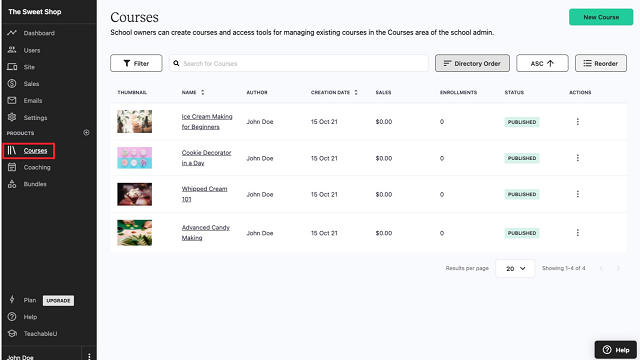
- Best for: Independent coaches, consultants, and tutors offering digital products and personalized services.
Teachable is a widely used Kajabi competitor that makes it easy to launch, sell, and manage courses or coaching offers with almost no technical overhead. If you’re an individual or small business with a few core services—say, a life coach selling a 6-week program or a tutor running weekly Zoom sessions—it gives you just enough to get started and stay organized.
Its key advantage is simplicity. You can build a landing page, host a video course, and start charging clients all in a single afternoon. The checkout system is fast, mobile-friendly, and integrates with Stripe or PayPal for smooth transactions. Coaching features allow for direct scheduling, progress tracking, and basic intake forms—all built into the backend.
Strengths:
- Perfect for selling courses and coaching services side-by-side
- Minimal learning curve, with drag-and-drop editors and preset themes
- Integrated payment tools and client management
- Built-in upsell and coupon functionality for basic marketing
- Solid mobile experience for both admins and users
Limitations:
- Limited site customization, especially compared to more flexible platforms
- Some of the better tools (like bulk email and advanced analytics) are locked behind higher-tier pricing
- Lack of live streaming or native video call support
Teachable is excellent for professionals who want to focus more on their work than on managing software. But if your business relies on personalization, recurring sessions, or more interaction-heavy services, you’ll eventually feel boxed in.
Podia
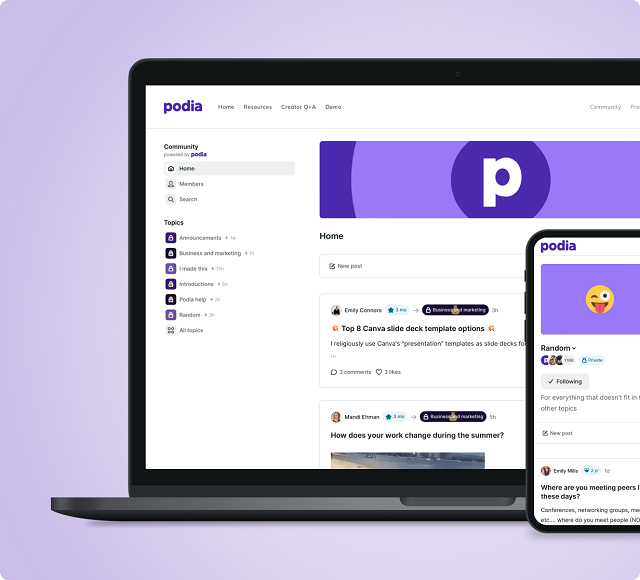
- Best for: Wellness professionals, life coaches, and creators looking for an all-in-one toolkit with minimal setup.
Podia markets itself as a no-fuss, all-in-one platform for selling digital products, memberships, webinars, and coaching sessions. And it largely delivers on that promise—especially for solo practitioners and small businesses that value ease over deep customization.
What sets Podia apart from other Kajabi competitors is how accessible it feels. You can start selling without configuring complex menus or digging through settings. Whether you’re offering a digital download, a paid webinar, or a monthly membership with exclusive content, Podia makes it feel like a single ecosystem.
For wellness coaches, fitness instructors, or nutrition consultants who host live sessions and share regular content with clients, Podia’s built-in webinar integration and email marketing tools offer real convenience. You won’t need third-party platforms to stay in touch or promote your offers—it’s already baked in.
Strengths:
- Native support for webinars, online courses, and digital downloads
- Built-in email marketing, including automation and newsletters
- Simple, modern interface that’s easy to navigate
- No transaction fees on most plans
- Allows you to sell directly without requiring third-party checkout pages
Limitations:
- Limited design flexibility—you’ll be working within preset templates
- Fewer advanced course features compared to Thinkific or LearnWorlds
- Lacks community-building tools like forums or member feeds
Podia is best for professionals who want everything under one roof without having to manage complex integrations. If your business model is straightforward and content-focused, it’s a great alternative to Kajabi. But if you’re building a more layered experience with coaching, group sessions, and deep user interaction, it might not scale as well.
LearnWorlds
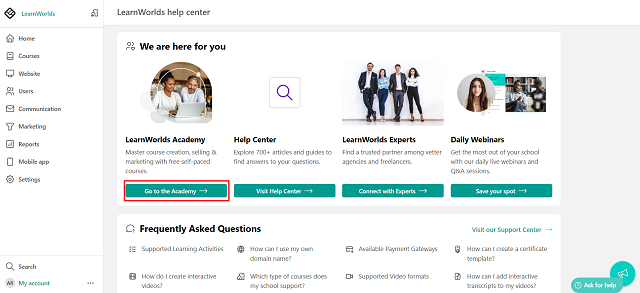
- Best for: Business coaches, training providers, and educators focused on interactive learning experiences.
LearnWorlds is one of the most powerful kajabi alternatives if your main priority is creating a rich, interactive educational experience. While other platforms offer video hosting and quizzes, LearnWorlds adds deeper layers—like interactive video overlays, built-in assessments, and certification tools designed for continuing education and professional development.
This platform excels in corporate training and knowledge businesses that want more than just static video lessons. It supports SCORM and HTML5, giving you freedom to add external learning tools. The learning analytics tools are robust, letting you track student engagement, completion rates, and even drop-off points within videos.
Its clean design is also geared toward multi-user experiences. Businesses with multiple instructors, departments, or learning tracks will find a lot of built-in flexibility. That’s why LearnWorlds is frequently used by business coaches, educational institutions, and e-learning providers with complex requirements.
Strengths:
- Advanced learning features like interactive video and dynamic assessments
- Built-in certification and compliance tracking
- Flexible course structures and modular design
- Strong analytics for student behavior and course performance
- Suitable for both solo educators and teams
Limitations:
- More expensive than some competitors at higher tiers
- Steeper learning curve during initial setup
- Not ideal for coaching-focused or consulting-heavy businesses
LearnWorlds is overkill for simple course delivery, but a dream tool for those building full-on learning environments. If you’re a coach or consultant aiming to productize your expertise into an accredited training program, this platform gives you the tools to do it professionally.
Scrile Meet
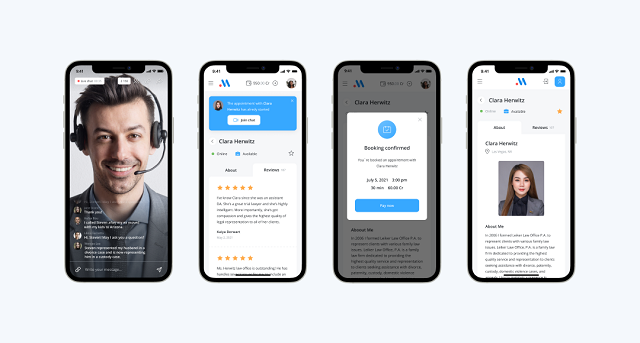
- Best for: Professionals who rely on real-time client interaction—consultants, coaches, tutors, and wellness practitioners delivering live sessions.
When it comes to kajabi competitors, most alternatives lean heavily on static course content or pre-recorded lessons. That’s where Scrile Meet breaks away. It’s not a course builder repackaged as a business tool—it’s a purpose-built platform for running a full consultation-based business online.
Unlike the other tools listed here, Scrile Meet is not a plug-and-play product with fixed templates. Instead, it’s a fully customizable development solution designed to help you launch your own branded platform for live video sessions, bookings, and paid consultations. Think of it as your own Kajabi-style business, but tailored around real-time services, not just content delivery.
Where most kajabi alternatives focus on selling digital goods, Scrile Meet is optimized for professionals who work face-to-face—or screen-to-screen. That includes scheduling, session management, messaging, and secure payments, all in one workflow. It’s especially appealing for coaches and consultants who’ve outgrown patched-together systems and want a unified experience under their own brand.
Strengths:
- Flexible infrastructure to fit different business models
- Real-time video, chat, and scheduling at the core
- Fully brandable with complete UI/UX control
- No forced templates or restrictive features
Limitations:
- Requires a more hands-on approach than out-of-the-box tools
- Best suited for those who want a truly custom build, not a generic toolkit
Scrile Meet isn’t trying to be a Kajabi clone. Instead, it’s for those who’ve already tried boxed platforms and are now ready to build something better.
How to Choose the Right Platform for Your Needs
No matter how polished a platform looks on the surface, what really matters is whether it fits your business model—and how easily it grows with you. The right setup for a solo wellness coach won’t necessarily work for a tutoring agency, just like a pre-recorded course system might not support live client sessions.
If your work is rooted in structured teaching—like educational courses or certification programs—your top priority is probably a solid content management system. Look for tools that support lesson plans, quizzes, certifications, and progress tracking. These features help you deliver a seamless student experience without the need for constant hands-on involvement.
Consultants, coaches, and service-based professionals often need more than just video hosting. Real-time scheduling, secure payments, and client messaging are all essential when your business revolves around live interactions. A platform that integrates those elements without external tools will save you time—and give your clients a smoother experience.
If you’re still testing the waters or operating with a tight budget, start by exploring free Kajabi alternatives. These can give you a feel for different interfaces and business workflows before you commit to a full build or monthly plan. Just be sure to check which features are included and what’s locked behind a paywall—you don’t want to start building only to hit a wall mid-way.
Lastly, think about where your business will be in 6 or 12 months. The best tool isn’t always the cheapest or most popular—it’s the one that supports how you work now, while leaving room to expand when you’re ready. Matching your tool to your growth plan is what sets up long-term success.
Why Scrile Meet Is the Best Custom Solution for Coaches, Tutors, and Video-Based Professionals
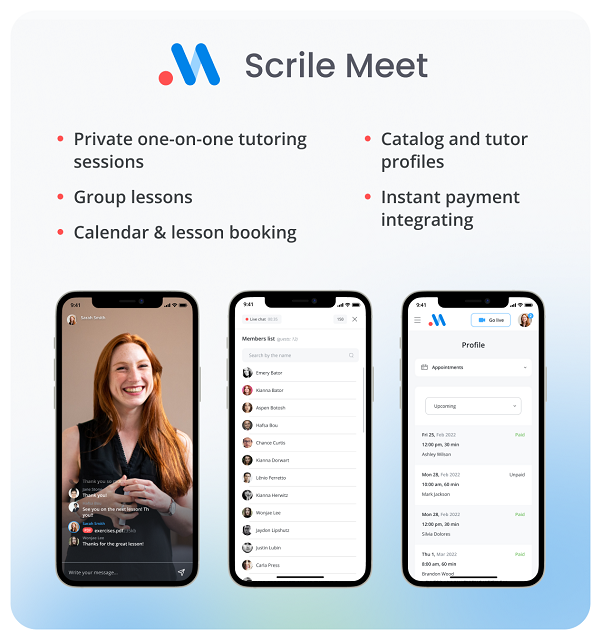
While many of the tools we’ve covered are excellent Kajabi alternatives for course creation, Scrile Meet was built for something different. It’s a software development service—not a monthly app subscription—and that distinction makes a big difference for professionals whose businesses revolve around real-time sessions, direct client relationships, and personalized digital spaces.
Scrile Meet helps you build a fully branded online consultation platform, tailored exactly to how you work. This isn’t about fitting your model into a prebuilt interface. You get complete control over the platform’s design, features, and flow—whether you run a video coaching business, manage a network of tutors, or host client sessions in wellness or business consulting.
What makes Scrile Meet stand out from other Kajabi competitors isn’t just that it offers video, booking, and payment tools—it’s that all of those features are developed specifically for your business. The platform can include:
- Real-time video chat and one-click booking
- Client dashboards with session history and messaging
- Custom pricing models: subscriptions, one-time fees, bundled services
- Secure payment systems, fully integrated (Stripe, PayPal, crypto if needed)
- Admin tools to manage availability, scheduling, earnings, and analytics
Unlike most Kajabi alternative platforms, there are no restrictions on how you scale. You can start solo and grow into a platform that supports dozens (or hundreds) of experts, with role-based access, branded interfaces, and even affiliate modules if needed.
Because Scrile Meet is delivered as a development partnership, you’re not just handed a login and left to figure it out. Their team works with you to plan, launch, and iterate—so the final product is aligned with your brand, your clients, and your workflow.
For professionals who’ve tried Kajabi and hit its limits—or who never wanted to be boxed into a course-first platform in the first place—Scrile Meet offers a more future-proof approach. You own your platform, your audience, and your monetization.
Looking to build something that feels like yours from day one? This is where you do it.
Final Thoughts: Choosing Smarter in 2025
The market for online business tools has expanded far beyond what Kajabi offers. You’re no longer limited to a single template or pricing model—and you don’t need to compromise your workflow just to fit someone else’s platform.
Whether you’re a tutor building out a hybrid learning environment, a coach running paid video sessions, or a consultant offering subscription-based access to your expertise, there are solutions out there that can match how you actually work. The best platforms are the ones that give you control over your brand, your customer experience, and your revenue—all without boxing you into a rigid system.
That’s why more professionals are turning to kajabi alternatives that offer flexibility and a better fit. With the right setup, your business can run smoother, scale faster, and reflect your unique style of working with clients.
If you’re ready to go beyond just selling courses and want to build something that works the way you do, explore what Scrile Meet has to offer. It’s not just a tool—it’s a development partner that helps you create a platform that’s yours from the ground up.
Now’s the time to stop settling—and start building smarter.

by admin
Back in the early days of remote work, hosting a virtual event meant firing up Zoom, sending out a calendar invite, and hoping everyone showed up. But by 2025, that’s ancient history. Virtual events have become a core part of how we work, teach, promote, and connect. From small workshops with niche audiences to international symposiums featuring hundreds of speakers, the demand for professional, reliable, and feature-rich solutions has exploded.
We’re not just talking about video streams anymore. Modern virtual conference platforms offer a full ecosystem: interactive stages, live chat, networking lounges, sponsor booths, analytics dashboards, and even AI-powered recommendations. Hosting a standout online event now means delivering real engagement and value—not just replicating a meeting in digital form.
Here’s the challenge: the number of tools available has grown just as fast as the events themselves. Some are sleek and easy to use but lack customization. Others offer deep features but require technical skills or large budgets. That’s why this virtual conference platform comparison exists—to help you figure out which platforms are worth your time (and your budget), depending on the type of event you’re planning.
In this guide, we’ll walk through the 10 best virtual conference platform comparison in 2025, highlight their unique strengths, and help you narrow down what works best for your audience, goals, and team size. Whether you’re hosting a virtual summit, an educational forum, or a full-blown branded expo, the right platform can transform your event from functional to unforgettable.
What Makes a Platform Best for Hosting a Conference?

Let’s be honest: you’re not just looking for a place to throw up a Zoom link and pray for engagement. In 2025, expectations for online events are high—and attendees can spot a lazy setup from a mile away. So, what separates decent conference hosting platforms from the ones that actually make people stick around, interact, and remember your event?
First and foremost: reliability. If your keynote speaker freezes mid-sentence or the stream dies during the Q&A, it’s game over. The best platforms for virtual conferences are built to handle high traffic, international time zones, and real-time interactions—without buckling under pressure.
Then there’s flexibility. You might be planning a tight, single-track symposium with a few dozen attendees—or a sprawling virtual expo with breakout rooms, sponsor booths, and overlapping sessions. The top platforms let you scale up or down, add modules, and switch formats without rebuilding the whole thing from scratch.
Let’s talk engagement. Chat boxes are great, but they’re just the start. You want tools that mimic the spontaneous hallway conversation: live polls, virtual networking tables, direct messaging, even speed-meeting functions. If people don’t interact, they don’t stay.
Don’t forget branding. Slapping your logo on a landing page doesn’t count. You want to build an experience that reflects your identity—from the lobby design to button colors. A good platform should make your event feel like yours, not a template.
And finally: analytics. It’s not just about who showed up—it’s about how they moved through your event. What they clicked, how long they watched, where they dropped off. Smart tracking helps you understand what worked and what didn’t—and do better next time.
In short: virtual conferences platforms need more than just video. They need structure, personality, and room to grow.
1. Zoom Events

Zoom’s event platform is built for scale. It takes what people already trust from regular Zoom and expands it into a system for large, organized virtual gatherings. It’s designed to handle everything from webinars and town halls to full-scale conferences.
With support for tens of thousands of attendees, Zoom Events offers multi-track agendas, ticketing, sponsor integration, and backstage access for presenters. It’s a strong option among conference hosting platforms, especially for enterprises that already use Zoom in-house.
Where it really works is hybrid events. If you’re combining a physical venue with a remote audience, this platform offers a reliable bridge between the two.
Downsides? Limited customization and a UI that still feels very “corporate.” Also, it’s not cheap—plans often start around $1,500/year and scale up based on your needs.
If you’re comparing tools in a serious virtual conference platform comparison, Zoom Events deserves a spot on the shortlist—for scale and reliability alone.
2. Hopin (Now RingCentral Events)
Hopin was built for events first—making it one of the more advanced virtual conferences platforms on the market. After merging into RingCentral Events, it’s still focused on recreating the energy of in-person events, but online.
Its key strength is interactivity: live stages, virtual booths, sponsor zones, 1:1 networking tools, and audience Q&A. It’s an especially good fit for marketing summits, product launches, and fast-paced events where interaction matters.
However, all that power comes with complexity. Hopin can feel bloated if you’re running something small or simple. The dashboard takes time to learn, and pricing can quickly escalate—reports suggest it starts around $800–$1,000 per event.
If you’re shopping around for a virtual summit platforms solution with room for sponsors and audience engagement, Hopin holds up. But it’s best suited for teams that have the time (and people) to manage its advanced features.
3. SpotMe
SpotMe isn’t trying to be everything for everyone. Instead, it doubles down on what it does best: high-touch, professional events—especially in corporate, pharmaceutical, and B2B spaces. It’s trusted by Fortune 500 companies and global medical brands, and for good reason.
The platform delivers real-time audience engagement features like polls, quizzes, personalized agendas, and breakout rooms—all wrapped in a clean, brandable interface. One standout is its support for fully customizable mobile apps, letting attendees carry the full event in their pocket.
SpotMe really shines in settings that require compliance, privacy, and content control—like medical conferences and investor summits. It also supports multilingual delivery, which is essential for global audiences.
If you’re comparing tools specifically for virtual symposium platforms, SpotMe makes a strong case. It’s serious, secure, and designed to support events where the smallest detail can’t be left to chance.
4. Webex Events (formerly Socio)
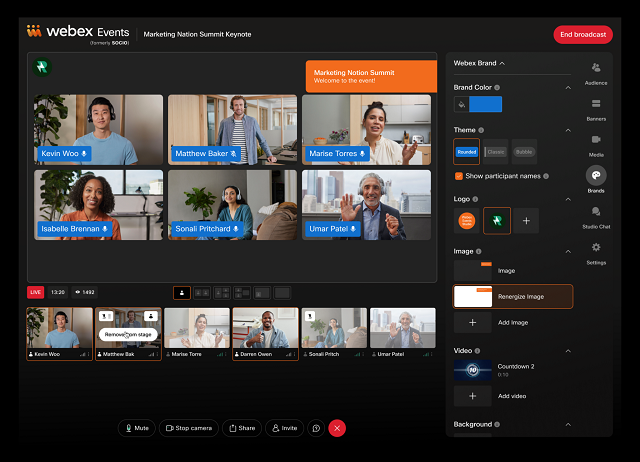
Webex Events comes from Cisco’s enterprise-grade ecosystem, and it brings that same polished feel to the event space. This is a platform built for scalability, professional branding, and complex agendas—perfect for when reliability matters more than flash.
What sets Webex Events apart in 2025 is how well it blends flexibility with structure. You can design multi-track events with detailed sponsor sections, in-depth analytics, and even gamification features—all without needing a dev team.
Custom branding is central. From pre-event pages to post-event surveys, you can shape the experience to reflect your organization’s tone and style. Sponsor booths, attendee networking, and live engagement tools round out the package.
Among the many virtual summit platforms, Webex Events holds its ground as a top-tier option—especially for enterprise organizations and global teams with complex needs. It’s not the cheapest, but it delivers on professionalism and scale.
5. Airmeet
If your event thrives on conversation, not just content, Airmeet is one to watch. Built for community-driven experiences, it emphasizes interaction over presentation. It’s ideal for workshops, education sessions, bootcamps, and any event where attendees want to meet, not just watch.
Airmeet’s virtual “tables” create space for networking, casual chats, or breakout workgroups. Speed networking, emoji reactions, and host controls make the experience feel less like a broadcast and more like a real event.
For organizers, setup is relatively easy. You can brand the event space, configure sessions, and even run ticketing without outside tools.
Among today’s virtual conference hosting services, Airmeet stands out for making events feel human—even through a screen. It’s less suited for rigid, formal conferences but shines when your audience wants to connect and collaborate.
6. BigMarker
BigMarker walks the line between webinar software and full-blown event platform. It’s ideal for marketers who want to turn webinars, demos, and online conferences into lead-generating machines.
At its core, BigMarker combines video hosting with marketing automation. You get features like built-in landing pages, email funnels, CRM integrations, and branded registration flows. That makes it a smart pick for companies running multiple small-to-medium events throughout the year.
Use cases range from training sessions to product launches and customer education events. Unlike some platforms that focus only on the attendee experience, BigMarker gives equal attention to the behind-the-scenes workflows—so your team can promote, manage, and follow up without jumping between tools.
While it may not be the flashiest on the market, it’s reliable and purpose-built for B2B marketers who need results, not just viewers. It’s a solid option in any serious virtual conference platform comparison, especially for lead-focused teams.
7. vFairs
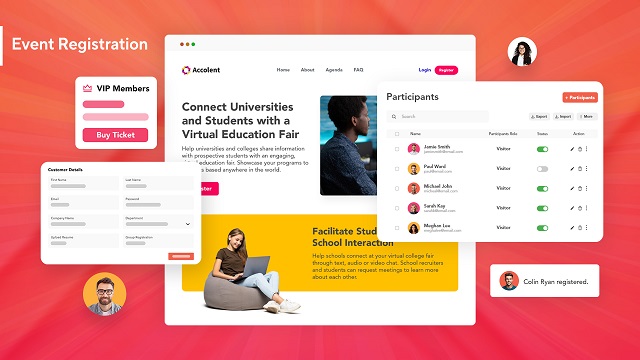
vFairs is built for virtual trade shows, expos, and career fairs—any event that relies heavily on booths, branding, and lots of concurrent conversations. It’s highly visual, with 3D lobbies, interactive exhibit halls, and customizable avatars that make the experience feel more like a digital venue than a basic webinar tool.
What sets it apart is the flexibility in design. You can replicate a branded convention center, organize content by theme, and give sponsors plenty of space to shine. Attendees can browse booths, download resources, chat with reps, and schedule follow-ups—all in one interface.
That said, it comes with complexity. Setup time is longer, and there’s a learning curve for new organizers. But if visual impact matters and your audience expects a “wow” factor, vFairs delivers.
Among conference hosting platforms, vFairs is an excellent fit for large, content-heavy events where first impressions—and sponsor impressions—really count.
8. HeySummit
HeySummit doesn’t try to be the biggest. Instead, it’s built for creators, coaches, and solo professionals running small, highly targeted online summits. If you’re running a niche event with a few guest speakers, gated content, and live or pre-recorded sessions, this platform gets the job done—without the bulk.
Its strength lies in simplicity. The interface is clean, the speaker onboarding is smooth, and it handles things like ticketing, registration pages, and session scheduling out of the box. You won’t need to patch together multiple services just to go live.
The platform is best for lightweight operations—people who care more about launching quickly and managing a focused audience than building an elaborate expo. Among virtual conferences platforms, it’s one of the easiest to start with, especially if you’re a team of one.
It won’t scale to massive multi-track summits, but for small events with clear messaging and a loyal following, HeySummit is more than enough.
9. ON24
ON24 is one of the few platforms on this list that was built with enterprise marketing in mind. It’s not just about hosting events—it’s about converting attendees into customers and nurturing those leads long after the webinar ends.
The platform excels in analytics and content lifecycle tools. It tracks how users interact with every part of your event—clicks, downloads, questions, poll responses—and rolls that data into your CRM or marketing automation system. For companies focused on demand generation, ON24 is a powerhouse.
It’s best suited for enterprises running multiple campaigns and needing clear ROI. With its branded experiences, always-on content hubs, and multi-session events, it works well for both live and on-demand events.
In virtual conference platform comparison, ON24 stands out for large organizations that need rich data, integration with existing tech stacks, and serious lead-gen capabilities.
10. Run The World
If most platforms feel like enterprise software, Run The World feels like a social app that hosts events. It’s light, fast to launch, and geared toward casual, high-energy gatherings like interactive panels, community chats, or expert roundtables.
The interface is fun, mobile-first, and made for audience participation. Features like cocktail-style speed networking, reactions, and co-hosted sessions help make virtual events feel less lonely—and more alive.
It’s especially popular among creators, thought leaders, and startups looking to run polished events without a huge learning curve. You won’t get complex sponsor zones or deep customization, but that’s not the point. Run The World delivers simplicity and interaction, not enterprise depth.
If your priority is speed, ease, and energy—and your event leans more toward conversation than keynote lectures—Run The World makes sense. It’s not for every use case, but in the right hands, it turns virtual conferences platforms into something genuinely engaging.
Need Something More Tailored? A Custom-Built Alternative from Scrile Meet

Even with all the polished platforms on the market, not every use case fits neatly into a pre-built box. For some businesses—especially those in consulting, coaching, healthcare, education, and wellness—the off-the-shelf tools feel either too bloated or too limited. They need something else: ownership, control, and the ability to build exactly what fits their audience.
That’s where Scrile Meet steps in. Unlike most SaaS options, this is a turnkey software solution that lets you launch your own fully branded virtual consultation platform—no coding needed, and no platform commissions cutting into your revenue. You get the infrastructure, the features, and the design flexibility—all under your control.
Here’s what it includes:
- Private video calls, both one-on-one and group sessions
- Appointment booking with calendar integration
- Paid access to sessions or messaging
- A built-in admin dashboard to manage users, payments, and analytics
- Fully customizable UI/UX so your platform matches your brand from day one
There’s no need for downloads or native apps—it runs right in the browser and works across all devices. And crucially, your data stays yours. That’s a big deal in industries where privacy and control really matter.
Whether you’re a coach running premium sessions, a legal consultant managing client calls, or a niche educator looking to monetize expertise, Scrile Meet offers a way to own the platform instead of renting space on someone else’s.
It’s not another app—it’s the framework to build your own. If you’re thinking long-term, this isn’t just a smarter move—it’s a future-proof one.
How to Choose the Right Virtual Conference Platform
There’s no universal “best” tool—only the one that fits your goals. Before you commit to anything, ask yourself:
- Are you hosting a free event, or selling tickets?
- Will you need expo booths, sponsor zones, or just a few speakers and Q&As?
- Is branding a priority, or are you fine with a generic look?
- How tech-savvy is your team—and your audience?
This guide’s virtual conference platform comparison should help you match your needs to the right tools. Platforms like HeySummit work for lean solo events, while Hopin or vFairs cater to big-budget, multi-track expos. Meanwhile, if none of them give you full ownership or flexibility, building your own platform (like with Scrile Meet) might be the right path forward.
Conclusion
Choosing the right tool sets the tone for your entire event. With virtual conference platforms evolving fast, it’s smart to think ahead—not just about your next event, but the next five.
Test a few, ask for demos, explore what’s out there—and if nothing fits, consider building your own. A fully branded platform like Scrile Meet gives you long-term control, monetization options, and freedom from third-party limits.
Use this virtual conference platform comparison as your starting point, and create something that actually reflects your vision.

by admin
The webcam chat industry has come a long way from simple one-way video streams. In 2025, platforms are expected to do more than just connect users—they need to engage, monetize, and scale. Live video alone isn’t enough. Audiences now expect private chat options, tipping systems, interactive overlays, and flawless streaming across all devices.
That’s where script chat cam solutions come into play. Instead of building everything from scratch, entrepreneurs and studios can launch fully functional platforms using pre-built or custom scripts that handle video, chat, payments, moderation, and more. These tools offer the control and flexibility needed to shape a brand, while also giving creators and performers the tools to earn and interact in real time.
This article explores the top five script chat cam solutions available in 2025. Whether you’re launching a new cam site or upgrading your existing setup, these tools can help you deliver a polished, profitable experience without compromising on features or performance.
What Makes a Great Script Chat Webcam Tool?
A solid script chat webcam solution is more than just a video player and a chatbox. At its core, it combines real-time video streaming with interactive chat, integrated billing, performer dashboards, admin controls, and user management—all built to support high-volume traffic and monetization.
But not all scripts are created equal. Stability and stream quality should come first. If a broadcast lags or drops, users leave. The interface matters too: performers need intuitive tools to manage shows, while viewers want smooth navigation and fast interaction.
Built-in payment options—like credit card billing, tokens, or crypto—are essential. Add moderation tools to prevent abuse, and you’ve got a platform that’s safer for everyone. Finally, look for scripts that support various revenue streams: pay-per-minute shows, tips, locked content, and private sessions.
Choosing the right solution from the beginning helps avoid major technical headaches later and lays the foundation for scaling your platform with confidence.
Top 5 Script Chat Cam Solutions in 2025
If you’re building a cam platform this year, choosing the right script chat cam tool can make or break your launch. Here’s a rundown of five standout solutions—each offering something different for startups, studios, and growing platforms.
Video Chat Script (Soft112)
This script is best known for its simplicity and straightforward pay-per-minute functionality. It includes a performer interface, admin dashboard, and multi-cam support for models, making it a decent pick for small teams or solo entrepreneurs starting out. It does the bare minimum like video chat and session billing, but otherwise, choices are limited. There isn’t a lot of customization, so expanding larger may mean expanding out of it. But it’s a fast and inexpensive way to get your foot in the cam door without a lot of initial investment.
Online-Webcam.net

Designed for fast deployment, this option gives users an entire plug-and-play site—complete with templates, performer accounts, and payment gateway support. It’s surprisingly flexible for a ready-made package. Performer dashboards are customizable, and it includes tools for show scheduling and revenue tracking. The only drawback is its slightly dated front-end design. It’s a practical pick for those who want to launch quickly and tweak things as they go, without building a platform from scratch.
PaidVideoChat by VideoWhisper
PaidVideoChat by VideoWhisper is a live video chat script tailored for pay-per-minute models, tipping, and interactive webcam chat. It’s ideal for platforms that want flexibility around pricing and session formats. The script supports private shows, multi-host interactions, mobile streaming, and can integrate with WordPress. It’s more technical to configure than some turnkey platforms, but makes up for it with performance and monetization depth.
xCams by Adent.io
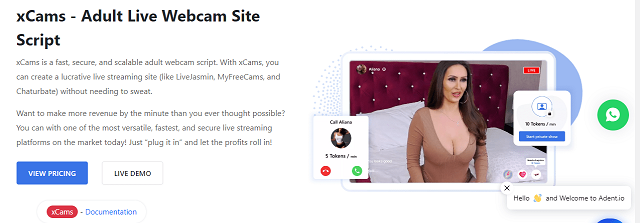
xCams by Adent.io is a white-label live cam site script with a focus on professional-grade performance and customization. It includes high-definition streaming, user and performer dashboards, token-based billing, and advanced moderation features. It is built for businesses that want to launch serious platforms with room to scale. It’s not a plug-and-play tool—you’ll want a developer or their team’s assistance—but in return, you get full control over how your cam site functions and grows.
Scrile Stream
Not a script in the traditional sense—Scrile Stream is a custom development solution. It offers flexibility far beyond plug-and-play tools, making it ideal for those wanting a branded platform with long-term growth in mind. More on that in the next section.
Scrile Stream: The Best Development Solution for Your Webcam Business
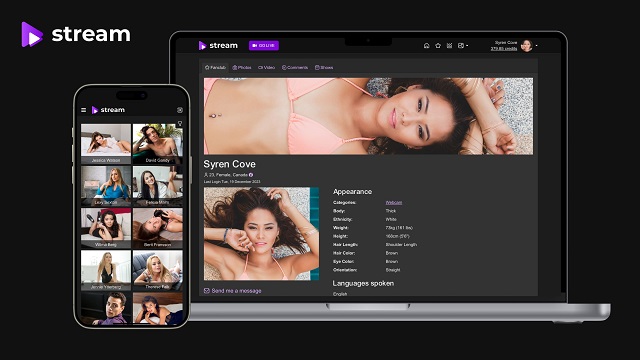
Unlike plug-and-play scripts, Scrile Stream offers a custom-built cam site solution tailored to your business model. It’s not just another template—it’s a full development service designed to launch powerful, branded platforms with real-time streaming, interactive chat, tipping systems, paid messages, and virtual tokens.
Scrile Stream also comes equipped with essential tools like affiliate program support, payment gateway integration, and moderation features that help keep your platform safe and monetized. It’s ideal for entrepreneurs who need more than a basic out-of-the-box system.
What sets it apart? Total control. No vendor lock-in, no design limitations, and full ownership of your platform’s code and user experience. If you’re looking for a serious script chat cam alternative with room to scale, Scrile Stream delivers.
Conclusion: Launch Smarter with the Right Script Chat Cam Solution
A good script chat cam setup is the key to any successful webcam site. Whether you’re going small or going big, the right technology will make you a sensation. Explore Scrile Stream to build a fully branded, revenue-capable webcam chat site built to succeed in 2025 and beyond.

by admin
Social media isn’t just a marketing instrument these days but a necessity for brands, agencies, and businesses looking to stay relevant and competitive. Yet, maintaining active, compelling presence on various platforms requires skill, time, and constant adaptation to algorithm adjustments and trending trends. For most businesses, it’s an operational burden, leading to missed opportunities and fragmented branding.
Having in-house social media managing personnel costs, as professional planners, creators, and analyzers must be hired. On the other hand, managing multiple client accounts as an agency has the effect of diluting the available staff. That is why businesses and agencies are finding more and more that they are searching for outsourced solutions that provide full-service social media management without the need to build everything from scratch.
The Shift Towards Scalable Social Media Solutions
Instead of struggling to keep up with daily posting, engagement tracking, and advertising optimization, companies are now adopting turnkey solutions that allow them to scale without the growing pains. Businesses want to expand their service offerings, while agencies want to increase revenue without adding operational complexity.
That’s where white label social media management services come in—providing an efficient, cost-effective way to offer high-quality social media services under your own brand. Whether you’re an agency looking to resell social media solutions or a business seeking automation and optimization, these services allow for seamless scalability.
In this article, we’ll explore the best platforms, posting software, and automation solutions that make managing social media easier. We’ll also discuss custom development options for businesses that want to create their own white label social media platform instead of relying on third-party tools.
What Are White Label Social Media Management Services?

White label social media management services allow businesses and agencies to offer social media marketing solutions under their own brand without having to build the infrastructure or hire a dedicated team. They are offered by third-party platforms that perform all the work, from the planning and dispatch of the messages through engagement monitoring and analysis to the management of the ads, but the reseller markets it as their own service.
White label solutions offer the simple solution for businesses, influencers, and marketing agencies to expand without the high cost associated with in-house development. Companies need not spend months building a custom social media software solution on their own. They may easily implement a proven solution created and focus on building their client base.
Key Benefits of White Label Social Media Services
One of the biggest advantages of using white label social media software is that it eliminates the technical and operational burden of managing multiple client accounts. Businesses can offer professional social media services without worrying about software development, platform maintenance, or hiring additional staff.
- No In-House Development Needed. No need to make any investments in automating software, software programmers, or social media planners. The provider does all the work.
- Scales Quicker and Client Acquisition. Agencies are able to include services in their portfolio immediately, boosting their revenue without the added work.
- Branded Experience End to End. The clients are provided with the fully branded experience, thus making the agency look as though it designed the platform internally.
Who Benefits from White Label Social Media Management Software?
These services are ideal for:
- Digital marketing agencies looking to offer social media solutions without hiring additional staff.
- Freelancers and consultants who want to provide fully managed social media services to their clients.
- Influencers and content creators seeking a way to monetize their expertise by offering social media management as a service.
- Large businesses and enterprises that want to outsource their social media marketing while maintaining full branding control.
With the right white label social media platform, businesses can deliver high-quality social media services, improve client retention, and grow their revenue—all without the hassle of running an in-house team.
Key Features to Look for in White Label Social Media Management Software

Choosing the right white label social media management software is critical for agencies and businesses looking to provide a seamless, branded social media experience for their clients. The best platforms go beyond just scheduling posts—they offer automation, collaboration, analytics, and security features that make managing multiple accounts efficient and scalable.
Social Media Scheduling & Automation
A strong scheduling and automation system is at the heart of any white label social media platform. Bulk posting, automated scheduling, and AI-driven optimization ensure content is published at the best times for engagement without manual intervention. Advanced tools allow agencies to plan weeks or months’ worth of content in advance, streamlining workflows.
Content Curation & Creation Tools
Social media success relies on high-quality, engaging content. Many platforms include pre-built design templates, AI-generated captions, and customizable graphics to help teams create posts quickly. An integrated library ensures consistency in branding with less human time spent creating the content.
Collaboration & Approval Workflows
Where agencies work with more than one client, collaboration across several users is a requirement. White label social media platform must therefore incorporate multi-user permission, approval workflows, and role-based permission to aid in maintaining the brand consistency. Clients should be able to review and approve content before it goes live, making communication more efficient.
Analytics & Reporting
Data-informed decision-making paves the path to social media triumph. A top-notch platform provides white-label branded reports, which facilitate agencies in offering bespoke performance metrics with their own branding. Engagement rates, audience growth, click-through rates, and measurement via ROI enable businesses to optimize their strategies and demonstrate concrete results to clients.
Client Dashboard & Branding Options
The best white label social media software allows for full dashboard customization to reflect an agency’s branding. This means custom logos, domain integration, and personalized interfaces, ensuring a seamless client experience that strengthens brand authority.
Security & Compliance
Having several clients’ accounts requires stringent security controls. Complying with GDPR, role-based access, and encrypted storage ensures that sensitive data is kept safely but in line with industry standards.
Selecting the right white label social media management platform ensures that agencies can scale efficiently, provide high-value services, and maintain full brand control without the need for in-house development.
Top White Label Social Media Management Services & Posting Tools
The right white label social media management services make all the difference for businesses and agencies that need to streamline content creation, creation, planning, and analysis under their own brand. From the many different white label social media software, the optimum selection would be one that has scalability, automation, brand-ability, and affordability as its criteria. Below are the reviews of some of the major platforms that offer white label social media posting and management solutions.
SocialPilot – Scalable Scheduling and Automation
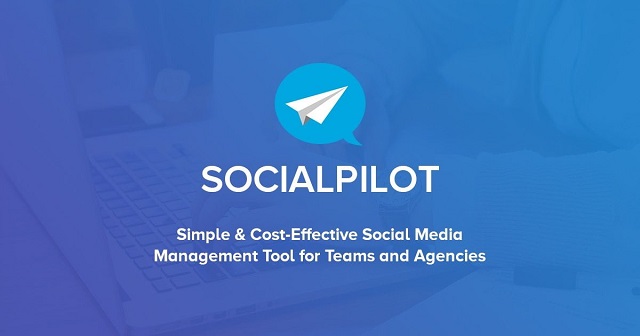
SocialPilot is a comprehensive white label social media platform designed for agencies and businesses managing multiple client accounts. It offers bulk scheduling, AI-driven automation, and custom reporting, making it an efficient tool for handling high-volume posting.
- Key Features:
- Multi-account management for social media teams.
- Automated scheduling to optimize post timing.
- Custom-branded reports for client analytics.
- Best for: Agencies that need affordable, scalable automation for posting and client reporting.
Sendible – White Label Dashboards & Team Collaboration
Sendible provides a fully branded white label social media app for agencies wanting a professional, customizable dashboard. The platform allows teams to collaborate on content creation, assign roles, and manage approval workflows before publishing.
- Key Features:
- Custom domain support for a branded experience.
- Client approval workflows to streamline content publishing.
- Advanced engagement tracking with built-in analytics.
- Best for: Agencies looking for a client-friendly white label social media management platform with strong collaboration tools.
PromoRepublic – AI-Powered Content Generation & Brand Management
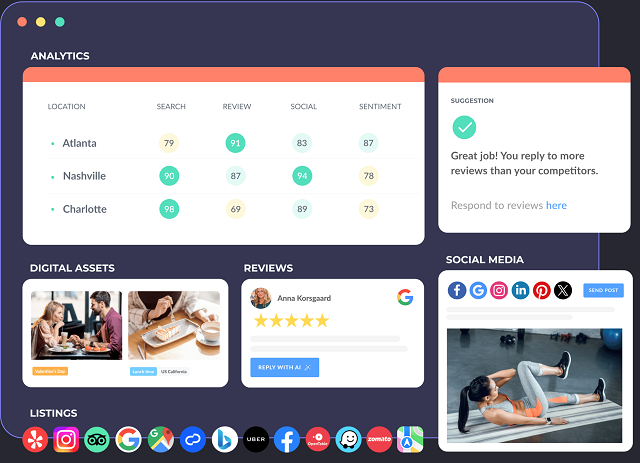
PromoRepublic stands out with its AI-powered content creation tools, helping agencies generate branded visuals, AI-generated captions, and industry-specific content suggestions.
- Key Features:
- Pre-made design templates for social media posts.
- AI-driven content recommendations based on engagement trends.
- Social media calendar management for better planning.
- Best for: Agencies that want content creation tools alongside scheduling.
Cloud Campaign – Ideal for Agencies with Automated Workflows
Cloud Campaign offers fully automated social media management, allowing agencies to run entire client accounts with minimal manual work. It’s built for resellers looking to scale efficiently.
- Key Features:
- Evergreen content recycling for continuous posting.
- Client-ready dashboards with full branding customization.
- AI-powered scheduling and automation.
- Best for: Agencies focused on automation and large-scale client management.
Vendasta – Full-Service Social Media Automation for Resellers
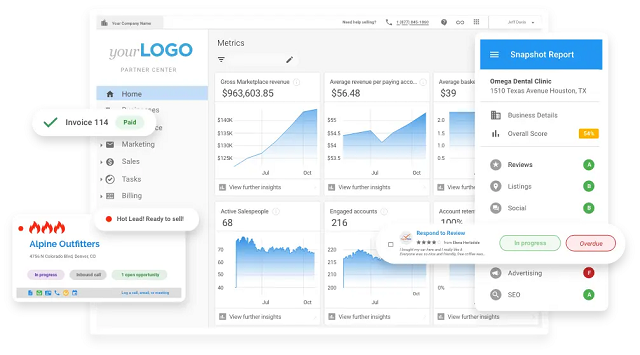
Vendasta is a white label social media software built for agencies, resellers, and digital marketers looking for an all-in-one marketing automation platform.
- Key Features:
- Pre-built white label solutions for social media, SEO, and PPC.
- Integrated social media posting tools with analytics.
- Scalable automation features for resellers handling multiple clients.
- Best for: Businesses looking for comprehensive digital marketing solutions, not just social media management.
The best white label social media services depend on business goals, budget, and client needs. For agencies looking for AI-powered automation, Cloud Campaign and PromoRepublic are excellent choices. If branding and client collaboration are priorities, Sendible and SocialPilot offer strong white label social media posting tools. Meanwhile, for resellers seeking full-service automation, Vendasta provides an all-in-one solution.
Using a white label social media management platform allows agencies and businesses to expand their offerings, improve efficiency, and maintain full brand control, ensuring a seamless experience for clients while scaling operations effectively.
White Label Social Media Platforms vs. Custom Development
When choosing between white label social media management software that is pre-built and developing your own platform, a business must consider its ability to scale, brand control, and long-term flexibility for clients. While “turnkey” sized solutions can provide a fast and cost efficient way to begin, they come with limitations upon growth and customization.
White label social media management software is meant for agencies who want an off-the-shelf software that is ready to use, and has features of scheduled posts, report analytics, and dashboard for clients. Platforms like these allow a business to use their own business name on the service, providing the same item for their clients without having to build it from the ground up. The big benefit is speed—only a few days are required for implementation, and hence it is well-suited for those agencies that must add services in a hurry. The drawback is that the solutions usually have limitations in the form of fewer features, and businesses are restricted to the capabilities of the software vendor.
Alternatively, custom solutions offer complete flexibility. Rather than having to conform to off-the-shelf software, businesses are able to build a fully branded, scalable solution that perfectly suits their business needs. Such solutions offer custom UI/UX to target audiences, enabling more interactive and personalized user experiences. It also provides complete control over monetization models, enabling businesses to offer subscriptions, content paywalls, or premium memberships without restriction.
For organizations needing full ownership and unlimited growth potential, bespoke development is the better choice. Although it requires greater initial investment, it allows for long-term scalability and total control over branding, functionality, and user data, making it a future-proof solution compared to off-the-shelf software.
Scrile Connect: The Best Custom Development Solution

For businesses looking to launch their own branded social media platform, Scrile Connect provides a fully customizable development solution that goes beyond generic white label social media management services. Unlike off-the-shelf social media software, which often imposes branding restrictions, limited monetization options, and dependency on third-party APIs, Scrile Connect offers a tailored approach to social media management that ensures complete control, scalability, and flexibility.
Scrile Connect is designed for businesses that want to own and operate their own social media platform without relying on external software providers and delivers a fully customizable social media management experience:
- Advanced UI & UX Customization. Unlike standard white-label solutions, Scrile Connect allows businesses to fully design their interface, adapting it to their brand identity, user preferences, and specific niche market needs.
- Automated Content Scheduling & Publishing. The platform includes built-in social media posting tools, allowing users to schedule, automate, and manage posts across multiple channels without third-party integrations.
- User Engagement & Interactive Features. Scrile Connect supports real-time interactions, content monetization, and private messaging, creating an engaging social experience for users.
- Comprehensive Monetization Options. Businesses can implement subscription models, pay-per-view (PPV) content, premium memberships, tipping systems, and live-stream monetization, ensuring full revenue control without third-party restrictions.
- Scalable Infrastructure. Whether serving hundreds or millions of users, Scrile Connect’s cloud-based architecture ensures fast performance, high security, and seamless scalability.
- End-to-End Security & Compliance. The platform provides GDPR compliance, encrypted transactions, multi-factor authentication, and AI-driven fraud prevention, ensuring a secure and trustworthy user experience.
- Data Ownership & API Independence. Unlike traditional white label social media software, Scrile Connect allows businesses to retain full ownership of their user data and operate without relying on external API providers.
Why Scrile Connect Stands Out from Traditional White Label Social Media Apps
Many similar applications place constraints on use of branding, monetization decisions, and growth for business owners so they can operate only within those constraints. However, when you discover Scrile Connect, you have:
- Full Customization. Business owners will be able to customize every thing about their own platform so that it is a distinct experience and can customize based upon audience influence.
- Full Control over All Revenue. Business Owners will never pay a percentage of their revenue for a subscription to an app to utilize their own; therefore there would never be a rollback of revenue or take a sense of ownership from the process.
- Seamless Integration & Expansion. With our API, Business Owners can administer their customized integrations with other application applications and do so without increasing any operational costs to their business while they effectively add functionality to their service.
For entrepreneurs, small businesses, and agencies looking for a fully customizable and scalable social media engagement platform, Scrile Connect is your development partner.
Conclusion
While there are currently many white label social management services, businesses can find scalable management platforms of social engagement without having to try to internally build their own. The right path should be driven by the business plan in place and if in fact it needed a takeaway model, some custom development or niche development. Scrile Connect presents the best fully customizable platform to own their brand appropriately with better social engagement and sustainable monetization model.
If you are looking for a scalable social media platform; if you would like custom premium features; individualized data ownership; and ability to deeply customize, give Scrile Connect a try today!



![]()
![]()























































